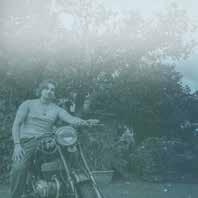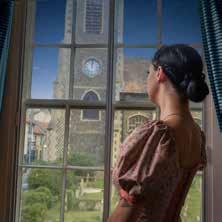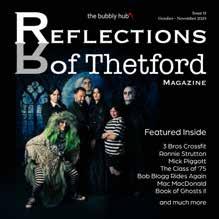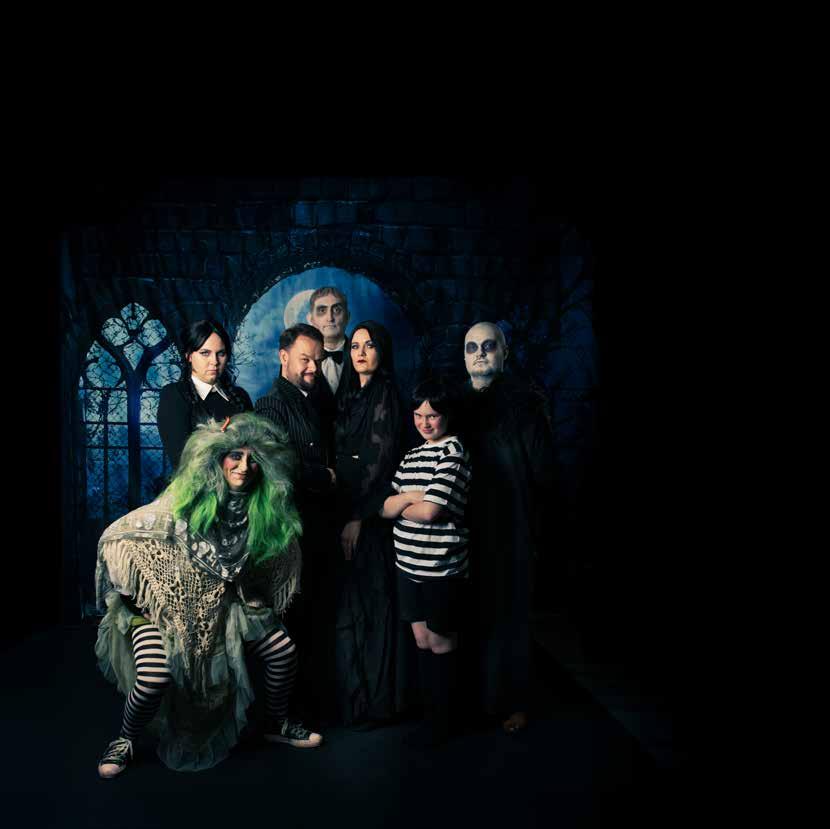

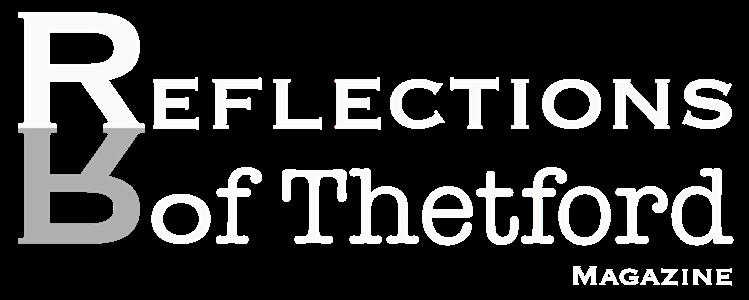














* Your sizes. Your selection.




1. Visit our showroom with your room sizes.
2. Order from our roll stock carpet, vinyl and underlay (Full price items only)
3. Arrange the collection or delivery** of your order. **Delivery charges will apply.



















* Your sizes. Your selection.




1. Visit our showroom with your room sizes.
2. Order from our roll stock carpet, vinyl and underlay (Full price items only)
3. Arrange the collection or delivery** of your order. **Delivery charges will apply.

Following on from their highly acclaimed ‘The Welkin’, Magic Floor Productions are about to wow the fair folk of Thetford yet again.
The Addams Family the Musical, Dracula-style set design, magnificent music, stunning lyrics, impeccable vocals, ghoulish charm, dark humour, the most unconventional family await.
Sit back, relax and be dazzled.
https://www.ticketsource.co.uk/magicfloorproductions/e-moeerk
Photography - @mangus.co.uk
Costumes and Cast - @Magicfloorproductions


by Martin Angus (Editor)
Welcome to Issue 11 of ‘Reflections of Thetford’ magazine.
A bit of a mixed selection of stories, but this is how we like it.
I have to confess that I have never been so nervous of including tales of Thetford, as I was interviewing our very own Ronnie Strutton. How am I going to ensure that it all remains family friendly I was thinking, but I need not have worried as Ronnie shared not only the more raucous stories, but also the quiet silent personal stories he has carried for decades.
Our front cover this edition is thanks to Magic Floor Productions, offering our lovely town yet another amazing production of ‘Addams Family - The Musical’, if you haven’t got your tickets yet you will need to get your skates on as they are selling fast (see page 18 for where to get your tickets).
Yannis appears on our pages this edition, for 40 years being one of the most well known estate agents in town, being someone I went to school with, it was a
privilege to hear his story so far and his sharing of the plans for next chapter in his life.
Tunnels, first hand WWII tales, the joy and positivity of volunteering, are just a few topics covered this edition.
And if you have ever wondered who those two blokes are that stand every day on the corner of the market square, then your question is about to be answered.
Bob Blogg rides again, and we have transcribed the second ghost story which was kindly donated to the magazine, rocketing our reader stats off the chart.
As always there is so much more in the magazine than I have the space to write here, please enjoy!
As I sat down to finish writing this introduction, we received some very sad news, one of our favourite contributors to the magazine has sadly passed away. Ray Hoskins, who appeared in issue 7, as ‘A bit of a Dark Horse’,our love and best wishes go to Joy and their family.
©Reflections of Thetford is published by The Bubbly Hub. All rights reserved 2025. Whilst every care is taken, the publisher accepts no responsibility for loss or damage resulting from the contents of this publication, as well as being unable to guarantee the accuracy of contributions supplied as editorial, images or advertisements. No part of this publication may be reproduced, copied or transmitted in any form or by any means or stored in any information storage or retrieval system without the publishers written permission.


3 Bros - Jack Bloss
Who’s this guy? - Ronnie Strutton
Service to our town - Mac MacDonald
50 Years On - Staniforth Class of ‘75
The Medusa Project - Bob Blogg
The Last Lookouts - Graham and Trevor
Four Decades in Property - Yannis Prodromou
A New Life in Norfolk - Ralph Mead Growing Together - Mick Piggott
Volunteering - Chelsea
Wartime Thetford - Terry and David
A Walk Amongst WWII Artefacts - Stephanie, Albert and Fergus
Will They Ever End - Thetford Tunnels
The Journey Home - Sandra Starling
Thetford’s Book of Ghosts - Book II Letters to the Editor


Written by Andy Eden
It is surprising what you can find on an industrial estate, particularly in Thetford. In amongst the small businesses, distribution centres and even some heavy industry, 3 Bros CrossFit has carved itself a niche. This will come as no surprise to anyone who is one of the many regular attendees but it was all new to me. I went to meet Jack Bloss, owner and head coach.
When I arrived, Jack was pounding away on a cycle machine, clearly someone who practices what he preaches. A few minutes later, with a coffee in hand, I asked Jack what exactly is CrossFit?
“It is functional movement performed at high intensity, varied form session to session.” So in simple terms, it’s a fitness program and

methodology. It is based on constantly varied functional movements which aim to improve general fitness, strength, heart health and flexibility. It has combined elements of other exercise and training disciplines to create something new. CrossFit was developed by Greg Glassman in 2000 in America and now has over 10,000 affiliated gyms around the world. Do you have to be fit to do this? I asked. No, everyone can come along. We all have to start somewhere and it won’t take long for your fitness to improve.
Jack first discovered CrossFit back in 2016. He had been serving in the RAF regiment and had just returned from a tour in Afghanistan. Married to Chanelle and with a young family, Jack decided to leave the military. Long periods away, either training or on a tour abroad, were not what any

of them wanted. Now a civilian, the fitness regime of the military was missing from Jack’s life so he looked around and discovered CrossFit.
2018 saw Jack coaching in Norwich and it was that year, after long discussions with Chanelle, that they decided to start the business, 3 Bros CrossFit.
With some money put aside for the startup and plans in place, they were almost ready but then Covid struck. As everyone was locked down there was no possibility of going ahead until the restrictions were lifted. The challenge then was to keep the family financially stable. Chanelle was a nursing assistant at the time, so Jack looked after their boys during the day then worked at Tesco’s during the evening. As with many people during that unprecedented period, it was a question of keeping a roof over their head and food on the table.
When gyms were allowed to reopen, they took the plunge and opened 3Bro CrossFit, originally based in Brunel way. I say ‘they’ because as Jack is only too ready to admit, Chanelle does a lot of the behind the scenes management and is a driving force in the business, that is when she is not running her commercial cleaning business. People were ready to get out again and the number of people attending the gym started to climb. Three years later, in November 2024, 3Bros CrossFit moved to its present premises in Napier Place.
With membership now at just shy of 140 members, obviously Jack could not coach everyone, so he took on extra staff. Now there are three coaches aside from Jack. Charlie, Dave and Phil. I hope Phil won’t mind me mentioning his age. At 63 he is fitter than most people with only half his years
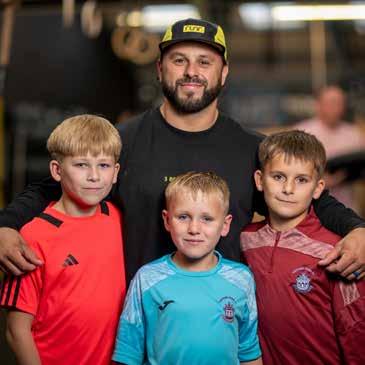
‘3 Bros with dad’ by Mangus Photography
and is an argument against the excuse ‘I’m too old.’
One corner of the gym is covered in certificates and medals from competitions where members of the coaching team and 3 Bros CrossFit have been placed, both here and abroad. It is an impressive testament to the quality and dedication of the coaches and serves to inspire everyone in the gym.
Jack does not just see 3 Bros CrossFit as a place for people to get physically fit and healthy though. When they moved into their present premises, Jack added a coffee percolator to the reception counter, filled from 3pm every day. He explained that he didn’t want people to just come in, exercise and then leave. He wanted to encourage a community spirit, and the coffee played its part. Almost immediately, he found that people would finish their workout then grab a drink. This meant that conversations were started and a sense of camaraderie began to grow.
Now, the gym is a very social place with everyone very supportive of their fellow members. People are encouraged on to achieve the best they can and its often the last to finish that get the biggest cheer. It’s not about doing better than the person next to you, it is about challenging yourself. Parents bring their children and get them into the habit of exercise. Classes for 12 to 16 year olds are held regularly. Spouses are encouraged to come and join in as well as friends and work colleagues making it a real community. Yoga sessions are also held on a Sunday as well.
3 Bros CrossFit works closely with Thetford Academy and runs classes during term time, often for pupils who have had problems getting on in
academic work. Once the training starts, everyone supports each other. Even those who perhaps stood a little apart from the group before. It really helps build team spirit. There is no back chat to the coaches, the physical exercise takes over and everyone wants to do well.
As you would imagine in today’s world, 3 Bros CrossFit has a social media presence on Instagram and Facebook. Jack also coaches online. So, what does the future hold? Well, there is work just starting to convert a store into a shower room for a start. In time, Jack says that they may open a second location but that is some way off. Beyond that, Jack would like to arrange regular competitions that involve all the fitness groups in Thetford. Perhaps something along the lines of ‘Thetford’s fittest’. Once again, the theme of ‘community’ comes to the fore.
So, I asked Jack, one last question. Why is it called 3 Bros CrossFit? The answer is that Jack and Chanelle have three sons, Sonny aged 8, Vinnie aged 11, and Ronnie aged 12 and it is named for them. So, when Jack talks about a family feeling to the gym and wanting to encourage families into exercise and a healthier lifestyle, it is easy to see where that comes from. The gym has become a real community and that can only be a good thing. If you are feeling a bit sluggish and want to improve your health and fitness, this may well be the place for you. https://3broscrossfit.co.uk/ https://www.facebook.com/3broscrossfit/ https://www.instagram.com/3bros_crossfit/
Tel: 07584 414181 jack@3broscrossfit.co.uk


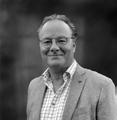
Written by Martin Angus
On Sunday someone will point at a photograph and ask, “Who’s this guy?” If we’re lucky, they’ll keep reading. Because behind the grin is Ronnie Strutton: butcher’s lad turned publican, footballing goalmachine, practical joker, reluctant emigré, occasional inmate, arm-around-your-shoulder friend, and the sort of natural raconteur who can turn a trip to the shops into a three-act play.
He is a man of Thetford now—though it took a while to arrive at that. His story is a mosaic of small-town myth and big-city memories, of scraps and second chances, of farce worthy of Ealing comedies and tragedies that leave a quiet weight in the room. It’s all here: the capers, the kindness, the chaos, and the closing advice he gives his younger self. If an editorial is allowed a thesis, let it be this: communities are knitted together not by perfection, but by people who belong to them loudly. And for better or worse, Ronnie has belonged to Thetford loudly for more than half a century. London to Thetford, 1963: “I Hated It… At First”

Ronnie was born in 1949. By the time he was 14, his parents had decided to swap London’s pace for Norfolk’s promise, landing the family in Thetford in the early 1960s. The move tore him from the teenage gravity well of Notting Hill—friends, mischief, and an early start to working life. He was, by his own cheerful admission, “a pain in the arse at school,” skipping lessons to ride dustcarts and sweep streets in a prized Royal Borough of Kensington cap. When a headteacher essentially offered the deal—find work and you can leave—Ronnie took it. Butcher’s aprons suited him more than algebra ever did.
Arriving in Thetford, he disliked what looked like emptiness. No pavements thrumming with drama, no instant spark of city life. Unless you had a bike, he says, “you didn’t do anything.” So they biked the common and carved little tracks into the scrub, and while his mouth still said “I hated it,” the place slowly began to work its quiet alchemy. You can hear it in the way he tells the story; the complaint is habit, the love is reflex.





t. 07891 294639
thegardenshedflorist.co.uk thegardenshed22@gmail.com

His father found work first at Hobal Engineering, then Thermos, before painting became the old man’s trade for the rest of his working life. His brother didn’t stick— love tugged him back to London—but Ronnie stayed. “Been here ever since. Wouldn’t move away now.” He tried once: a brief, sunny spell in Tenerife with Eve, the woman who would anchor the next three decades of his life. He loved it; she missed home; and a pact is a pact. They came back.
Home, then, is Thetford. But it’s also London in his bones—early impressions formed under the pavement level, literally. He remembers his mum tucking the kids under a bed when the Notting Hill race riots spilled past their basement window, car tyres and shouting at eye level. It’s a small boy’s postcard of fear and fascination, and it tells you something about Ronnie’s lifelong habit of standing close to the action.
The first job in Thetford was a factory post on a fly press—monotonous, unforgiving, “a shit job” in his crisp summary. He didn’t last. But the butcher’s trade pulled him back: Baxter’s down the town, where he put in a few steady years. He can still walk you to the spot—under an arch and along King Street—that’s long since been rebadged and rearranged by time. The landmarks have changed; the muscle memory hasn’t.
From there the CV becomes the full Ronnie: bits and pieces, steady graft and side-hustle favours, a knack for getting on with people who didn’t get on with many. He worked for the late Mick Croxton—Crocky, reputedly the hard man of town—clearing the old stockade whenever a refresh was due. “He was good as gold with me,” Ronnie says, and the sentence sits there, simple and unforced: you could either get along with Ronnie or spend years failing to.
Soon enough he became what some towns are lucky
to have: a publican who is more than a landlord. He ran the Trowel and Hammer for years, then the Rose and Crown, the Green Dragon, a stint holding the fort at the Red Lion in Caston, even a rural place near Sandringham with a glass shortage so dire he had to summon backup. He fixed the glass problem, filled the bar with carrot factory workers finishing shifts and polishing off Pilsner from the bottle, and made the night hum. Good pubs are theatre; Ronnie understood stagecraft.
The work took him outside of pubs too. There was a time subcontracting for TNT, shuttling bank cheques from Suffolk to Milton Keynes. Parked one afternoon, he hears a radio piece on alopecia and rings in. The researcher asks what worked. Straight-faced, Ronnie offers the advice a doctor once gave him—rub the patches with your finger tips while watching telly, something about static—then delivers the punchline: “I ended up with hairy fingers.” The studio collapses; the producer never gets him to air. You don’t put a man like that on a delay and win.
Thetford Then and Now
Ask Ronnie how Thetford has changed and you’ll get the unvarnished version: the wistful defence of a “lovely little town,” the cranky lament for what’s been lost, the grumble about today’s messes, the laughter puncturing the gloom. There’s no politician in him; there is plenty of pride, and some edges, too. Memory is a fierce editor. What remains constant is belonging. Even when he vents about the present, it’s the investment of a man who has given his seasons to this place and raised daughters and grandkids here, who goes down the town and is greeted by name by coppers he once belted—more on that in a moment—and bar staff he trained decades ago.
If this were a civics lecture, we’d footnote the forces that reshape towns—economics, migration, policy, time.



www.ticketsource.co.uk/magicfloor-productions www.ticketsource.co.uk/magicfloor-productions

But this is Ronnie’s editorial, and the truest fact is that he never left. He fought for his place in it (occasionally literally), built businesses in it, found love in it, and is still telling stories that stitch the town together. That’s a kind of citizenship.
Some men mellow with age and erase their own roughness. Ronnie prefers honesty. “Up here, I got known for fighting,” he says, with the shrug of someone who doesn’t particularly recommend it. There were the squaddies, the Americans, the weekly rows that congeal into folklore. If there was a magnet for the Saturday night melee, it was the Rites of Man down Brandon Road—now a hall, once a ring. He, Riggs, and Donut would be barred on Friday and in through the door by last orders, three free pints deep, because the only thing more predictable than a bar ban is the joy of breaking it.
Yet the heat of the night made room for lifelong friendships, and not only with the lads at his shoulder. He tells a story about Horry Bunting, a policeman who rose to inspector and whom Ronnie came to love. Their first meeting ended in a wallop—Horry trying to break up a fight, Ronnie in the mood to oblige no one. Years later at Bunting’s packed funeral in Diss, a speaker recalls the night he was “hit harder than ever in my life,” and a hundred heads swivel quietly toward Ronnie. He had long since gone to see the man in his final days. “Lovely man,” he says—a phrase he uses often, always about people, never about himself.
The police, as it happens, allegedly made allowances for this particular rascal. He played rugby with them and they tipped him off about roadblocks, steering him around checkpoints when his paperwork was more wish than fact. One veteran officer once stopped him just to introduce a new recruit: “This is Ronnie. He’s got no





licence, no tax. Leave him alone.” It reads like myth. It isn’t.
The best measure of Ronnie’s appetite for sport may be the nine goals he once scored in a single match—nine, as in all of them—in a 9–0 thumping of Brandon. The Americans on base invited him to join their inter-base team after he kept leading the line in annual friendlies; he declined rather than swap passports or board a plane. Thetford Rovers, Town, Brandon, Lakenheath, Barningham—he pulled on shirts the way working men in market towns always have, wherever there was a game, wherever a manager thought, “Get Strutton.”
Football held him longest, but rugby had its charms, especially when suspensions in one code encouraged a sabbatical in the other. He loved the third XV, the proud anarchy of it, the afters at the bar. Sport gave him a ladder up into community: a way to sort out disagreements without a court date, to belong to a team sheet, to have his name read out on a Saturday.
Eve walked into the Trowel and Hammer looking for a previous landlord named Ian. She found Ronnie instead. Within weeks she had a job back in London; within months she had Ronnie. He says the dates, then recalculates the dates, then lands on what matters: thirty-five years together, married in 1990 at Watton.
The wedding is pure Strutton theatre. Guests took the invitation “just turn up” literally—eighty people crammed into the registry office. When the registrar reached “any lawful impediment,” a mate in a gorilla mask twice shouted “Yeah!” and found himself educated, briskly, about the seriousness of the moment. Weeks later the registrar shows up to a fancy-dress do at the pub, laughing. “Funniest wedding I’ve ever done,” he said. It’s
not exactly church bells, but those who know Ronnie know the sound of joy when they hear it.
He had been married before; he speaks without rancour about the past and with fondness about the three daughters who stayed local. Eve, meanwhile, is the partner every publican needs: tolerant of late nights, fearless with banter, and—for one brief adventure— brave enough to try Tenerife with a man who absolutely would have stayed. They laugh a lot, Ronnie says. He trusts her. She gives as good as she gets. It’s an ordinary, glowing review of a long marriage.
Capers, Collections, and a Yellow Elephant
Every town keeps a cabinet of local legends; Ronnie’s fingerprints are on at least two drawers.
First, the collection. In the wake of the Harrods bombing in 1983, a group of them went pub to pub raising money for the police officers’ families. Ronnie dressed as Father Christmas and waddled into a rugby club packed with a touring side. One bloke resisted the bucket. “Father Christmas says if you don’t put something in,” Ronnie told him, deadpan, “you’re going to get the biggest right hand you’ve ever seen.” Coins flew. In the end they upended a bucket of change onto a police-station desk—no counting, no ceremony—and the tally came back at £71. In small-town economics, that’s a princely sum, and in small-town ethics, it’s the point.
Then, the elephant. Happily, this one is comic and mostly harmless—though the police, the Happy Eater at Red Lodge, and a puzzled manager behind a curtain might disagree. Six of them, a trailer borrowed with a friendly key and a story about picking up paperwork, and a plastic elephant liberated after a recon mission proved it wasn’t bolted. The plan foundered on the bright idea to drive past the base; blue lights arrived, eyebrows raised. “Why didn’t you stand it up?” one officer asked. “We did stand it up,” replied Ronnie’s mate Riggs. “He



The story even made the national press.
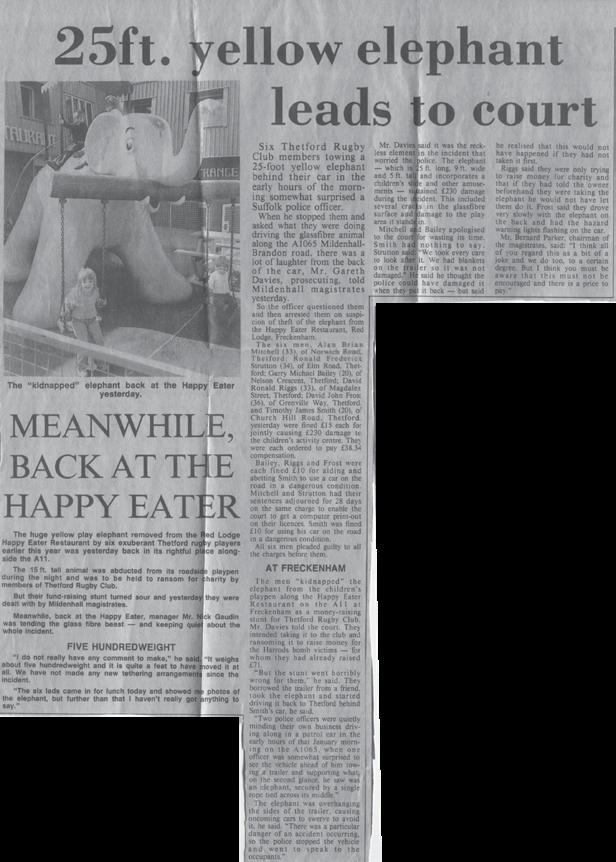
was tired. It just lay down again.” In the end they were nicked for damage rather than theft—“someone had to be blamed, I suppose”—and shuffled in and out of court until a magistrate looked at the case, looked at the lads, and decided enough was enough.
Not every stunt ended with a chuckle. Once, as teenagers, they staged a mock post-office robbery with an old starting pistol, scattering shoppers who had no idea the guns were blanks. It was a daftness that reads differently in a post-2000 world, but this was a different time and a different town. Ronnie tells it with obvious shame and equally obvious fondness for the idiot swagger of youth. The point isn’t to excuse; it’s to recognise a life in context.

Shadows and Reckonings
No editorial worthy of the life would skip the darker chapters. Ronnie doesn’t. In his twenties he fell in with three men and took part in a real robbery on base. He calls it out plainly: not what he was, not what he wanted to be, but what he did. He served time. Inside, as outside, he made a kind of family of it—earning a nickname he gleefully repeats (“the poison dwarf,” courtesy of a towering prison guard with a mouth to match) and a Sunday reprieve to play football for the prison staff’s team. On release day a sergeant threatened to haul him back if he mouthed off on the train; Ronnie couldn’t resist a parting volley as the carriage pulled away, then nearly died of fright when Ely was crawling with police for reasons having nothing to do with him.
Years later came the worst night of his life, one he will go to his own grave turning over. Working the door as a bouncer at the Mill, he pushed across a crowded room to head off a row and a young woman—known to him and his family—fell. She was drunk, he says. She died. The charge was ultimately described as an unlawful killing. Ronnie changed his plea to guilty on the judge’s pointed assurance that he would go home rather than





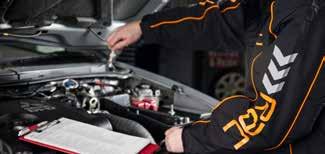

face a long sentence, and he has lived with the scar tissue of that paradox ever since: a legal outcome that stayed his course and a moral result that broke his heart. “One of the worst things that ever happened to me,” he says softly. Years later, a relative of the woman—after long bitterness—approached him in a pub and kissed his cheek. “I’m sorry for all the trouble I caused you.” Forgiveness is never owed; when it comes, it lands like grace. You can hear in Ronnie’s voice that it did.
He tells another story that is harder to set down. When an immediate neighbour allegedly targeted local girls with abuse, Ronnie admits he didn’t wait on process. He went through the man’s door and did what magistrates call grievous bodily harm. The bench fined him the doctor’s fees and remarked, in open court, that the victim “deserved all he got”—a line that will rattle readers who prefer our systems tidier. What do we do with this? An editorial is not a judge. But it is obligated to hold two truths: that vigilantism corrodes us, and that the instinct to shield children is as old as neighbourhoods. The story, like the man, refuses to sit in one box.
Being Known
List the names and it reads like Thetford’s roll call: Crocky, Dougie Nemo, Barry Keymer, the marketplace faces who bantered with everyone’s nan, the rugby blokes who lived for third halves, the coppers who winked and the coppers who didn’t. Some are gone now—“old Riggs,” Ronnie says, voice lowering; it’s the only time you see him appear small—but they populate his stories like saints in stained glass. He is proudest that most of his closest mates were locals. He arrived a London lad; he became a Thetford man.
If you want to feel the social map of those years, ask where people gathered. “Rites of Man,” he says without a heartbeat’s pause. If you want to know what it meant
to be barred on Friday and welcomed on Saturday, to owe a fiver from payday to payday and still have the landlord push a pint your way, to be absolutely skint but fully wealthy in friends, go sit under the old beams in your memory and you’ll get it. Ronnie’s life is civic glue of this kind.
No portrait of Ronnie is complete without the routines and punchlines, the quips that fall out of him as easily as breath. Many of them aren’t reproducible in a family paper; many more depend on timing you can’t print. But the gist of the canon is this: he thinks quick, he puts people at ease, and he tells stories with the precise, mischievous rhythm of a man who has always loved an audience.
He once told a registrar that he would bring half the county to the wedding and did; he once told a rugby forward in a Santa suit that generosity would be a wise decision and proved it; he once told a radio researcher the joke about static electricity and hairy fingers and broke the poor woman clean in half. In pubs and on touchlines and leaning over market rails, he has been running the same show for decades, and the town has been happy to buy a ticket.
The first family home in Thetford was No. 2 Elm Road, new enough that the fences hadn’t gone in. The openness feels symbolic now. He tells a bawdy tale about the parties across the green in those early estate years, complete with a local woman interviewed on national news as if she’d sprung from a convent. The point isn’t the gossip; it’s the music of early Thetford estates, the optimistic chaos, the way a street becomes a family whether it means to or not.
Ronnie’s own family spread out but mostly stayed close.


Two sisters in town, another in London, a cab-driving brother-in-law who commuted from Thetford every day—a fact Ronnie insists is true no matter how many eyebrows shoot up. If the editorial had a soundtrack, it would be the noise of a big clan in and out of one another’s kitchens, kids shoved two-at-a-time in the front of a bike for rides around the block, the ordinary ways a life gets full without anyone noticing the fullness happening.
By the end of any long conversation with Ronnie, two strong impressions remain. The first is that he is, and has always been, gloriously programmable for laughter. He will knock on the window of anyone’s day and leave them lighter than he found them. That matters more than we give it credit for in a time that drifts toward bile.
The second is that he is unblinking about the parts of his life that hurt. He does not pretend he never fought; he doesn’t pretend he never crossed lines; he does not dodge the tragedy that lives in his chest. If a community is honest, it doesn’t idolise or exile such men; it holds them near enough to be complicated. The editorial tone here, therefore, is deliberate: warm, not hagiographic; candid, not cruel.
What advice would he give the younger Ronnie? “Don’t be like me,” he says, and then defines what he means. He never walked away. When trouble came, he stayed, all the others legging it, and that, more than any grand design, is how he ended up where he ended up, again and again. He doesn’t wrap it in false romance. He simply says he’s laughed most of his life and that he’s still laughing now, mostly with Eve, who tells him to behave and doesn’t always expect compliance.
There’s another moral tucked in a smaller moment. Once, he says, the step-daughter of one of his best mates walked into the pub with her first wages. Ronnie grabbed the packet and bought a round for the house.
Nobody who knows him is surprised. It is possible to see this as madness; it is also possible to see it as theology. In the economy that matters most—the one measured in favours and opportunities and people who’ll turn up when you’ve got a skip to fill—Ronnie has always been rich.
An editorial usually ends with a crisp summation, something elegantly phrased and dignified. Ronnie would hate that. He would prefer, I suspect, a line that sounds like him and leaves room for the next laugh, the next pint, the next story told on the marketplace to whoever is new in town.
So here is that ending:
On Sunday, someone will point at a photo and say, “Who’s this guy?” He’s the lad who hitchhiked the wrong way out of Thetford at 14 and still came home. He’s the butcher who knew the archway by heart and the publican who could fill a bar with glasses no one had the first day. He’s the footballer who once scored nine and the rugby scrapper who turned coppers into mates. He’s the bloke who raised £71 in small coins by threatening, as Father Christmas, the biggest right hand you’ve ever seen—and the bloke who knows full well that some chapters of a life do not end in laughter and never will.
He is, in short, a Thetford story. Not tidy. Not exemplary. Unforgettable.
If you want him in one sentence, borrow his own: “Everyone knows me for laughing and taking the p*ss.” It is not the worst epitaph a man could hope for. And it’s not yet time for epitaphs, anyway.
There’s a town still to disagree with, a wife to tease, a joke to ring into a radio show, and, with any luck, an elephant to set back on its trailer, upright this time, so as not to attract attention.
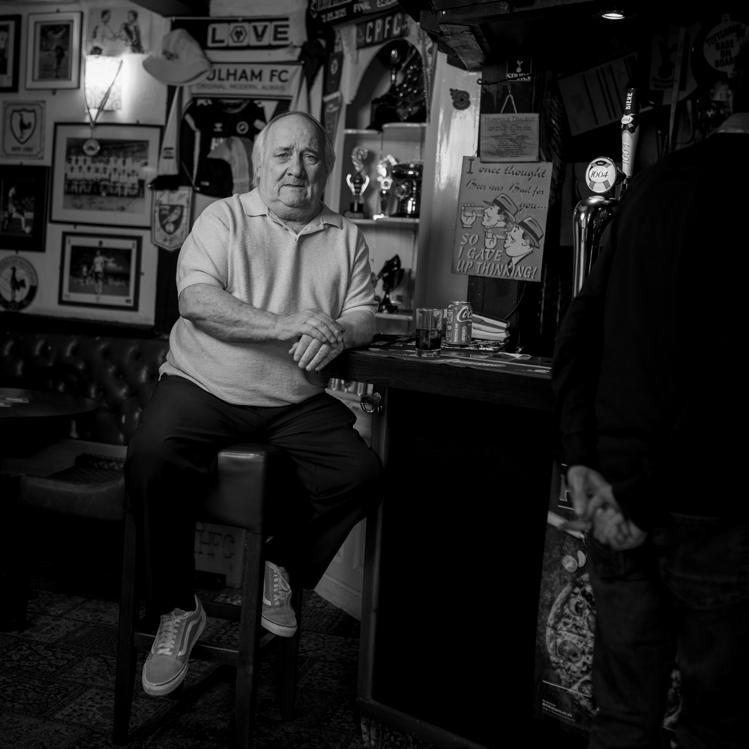


Written by Martin Angus
On the day the Berlin Wall fell, 9th November 1989, Mac MacDonald was 8,000 miles away, standing in the bar of the Upland Goose Hotel in Port Stanley, having said his vows just two months earlier. It was 9 September 1989. He and Sue—both RAF—became, as far as anyone can tell, the first forces couple married in the Falkland Islands. “We rekindled our relationship down there and she asked for commitment,” Mac says with a grin. “I was a young lad. I said ‘okay’—and we did it.”
Such sentences reveal a lot about Mac MacDonald: decisive, practical, prone to underplay the audacious. They also foreshadow the arc of a life that runs on a simple, hard-won fuel: service. Four decades in uniform. A move to Thetford that he’ll tell you was the best decision he and Sue ever made. Years of litter picks and residents’ meetings and speed watches and stubborn committee work. An MBE for building bridges between base and town. And, in the past year, the frank recalibration of a family facing cancer together. Mac’s story is not the tidy narrative of a career politician.

He insists he never wanted politics at all. Yet the town now knows him as an independent councillor who answers emails, sweeps streets, stakes positions, and— when necessary—absorbs the frustration of things that can’t be changed overnight. This is the portrait of how he got here, why he stays, and what he thinks Thetford needs next.
Letchworth to Lossiemouth: the long apprenticeship
Mac was born in Letchworth, Hertfordshire, “in my grandmother’s house on the A505,” he says, the detail offered the way service people track the world by roads and runways. His dad was a double glazing salesman; the family moved with the regional patch to Oxfordshire and settled in Didcot. “All my school years were there— until I was 18, when I joined the Air Force. Shortly after, Mum and Dad moved, so I never went back to Didcot or Oxfordshire again.”
He enlisted on his 18th birthday. The first posting— Lossiemouth—felt like “nosebleed territory… being that

far north.” Then Peterhead, further still. In 1988 came Berlin, behind a wall that came down while Mac was on detachment to the Falklands. “It was a weird feeling,” he says. “You’re away doing your job and the world shifts back in Europe.”
Sue had also been in the RAF, a stewardess. The military’s geography separated them; marriage brought her to Berlin, but female postings in her trade weren’t available there then. She left the RAF to join him and worked as a stewardess at the villa of the Chief of the General Staff. A year later she rejoined; together they began the long, familiar dance of “together postings” that could still mean half a county between you. Wiltshire for her at Upavon, Wiltshire-but-not-really for him at Hullavington—close in military terms, far enough in family ones.
Northern Ireland came with a daughter and the logistical calculus of two serving parents. “By the time our daughter was four, she was on her fifth house,” Mac says. “Something had to give.” Sue left regular service for stability. The postings rolled on: Lincolnshire, Oxfordshire, Buckinghamshire, back to London—and then Bavaria.
Teaching NATO about the unthinkable
Oberammergau, famous for its Passion Play and fairy-tale setting, has another identity: home to the NATO School. Mac spent three years there teaching what no one likes to think about but everyone relies upon professionals to understand—“Weapons of Mass Destruction,” he says plainly. “I taught nuclear plotting and chemical reaction cell control for all of NATO.” The work took him from Washington—where he received NATO’s Military Member of the Year award from General James Mattis—to Moscow’s Combined Arms Academy, to Macedonia.
The job was absorbing, but “isolated for a family.” When promotion called, he returned to the UK in 2008 to

Freedom of Thetford Parade
(Sylvia Armes in the background)


RAF Honington—a posting he admits he didn’t relish on paper. “It’s our depot; can be inward looking,” he says. “But it turned out to be brilliant. I’m still there.” He cycled through six or seven roles, finishing as Station Warrant Officer, the senior Warrant Officer on station—a job that came with responsibilities that mattered locally, including orchestrating the RAF Freedom of Thetford parade.
He left the regulars in 2022 and joined the reserves the next day, initially splitting his week between two days in uniform and three with the Commonwealth War Graves Commission. “I loved the War Graves work,” he says. As the reserve role grew, he moved into the RAF’s Land Activity Safety Team—health and safety across the service’s non-flying activity. “Not the most dynamic thing to talk about, but essential,” he says. Vehicle accidents, noise injuries, root-cause analysis and mitigation. “It’s about finding solutions, and keeping our people safe in a job that is often full of risks”
He also manages the RAF Regiment Heritage Centre at Honington, an expansive, behind-the-wire museum that most locals don’t know exists. “About 40,000 square feet,” he says. “We do get a lot of visitors by arrangement. You must come and do a piece on it.”
Alongside all that, Mac serves with the King’s Bodyguard of the Yeoman of the Guard, the sovereign’s ceremonial bodyguard—the ones who look like the Beefeaters but aren’t. “We are summoned for duties such as State Opening of Parliament, investitures, lying-in-state… in fact almost all state ceremonial events,” he says carefully. Protocols restrict social-media fanfare, so he references it quietly, as one of those duties you carry because you were asked and because it’s right. “We wear a cross belt,” he adds, the sort of detail a military mind values. “Designed to hold an arquebus.”
Thetford: reluctant move, joyous belonging
Honington brought the family to Stanton first, then
Walsham: village life, beautiful but “a bit out of the loop” with a teenager in the house and two commuting parents. Sue shopped in Thetford because it had the supermarkets; Bury St Edmunds had the job and the pull of habit. “She said, ‘What about Thetford?’ and I said, ‘I don’t know, I’ve never really been.’ I was reluctant, really. And it was the best move we’ve ever made.”
They arrived around 2011. Fourteen years on, Mac calls Thetford “home” without hesitation. “After all the years of travelling around… we’ve lived in a lot of places and this is good. We’re lucky to live here. Our daughter lives less than a mile away in town, with her husband and our grandson. It’s superb.”
There is a conviction underneath the contentment: Thetford is not a compromise. “People are quick to run it down,” he says. “I’ve lived around the globe. Nowhere is perfect. In Uxbridge we were privileged—and the crime was off the scale. Here, one incident becomes the story. Someone graffitis a chair and it’s huge. We need perspective. The most important thing for this town is positivity. Get involved. Enjoy it.”
Mac’s route into local politics wasn’t paved by manifestos but by bin bags. “There was a lot of rubbish around,” he says. “You can either look at it and say that’s terrible—or you can do something.” He and Sue turned a one-off tidy into a regular, monthly litter pick through the Norwich Road Residents’ Association. “We’d borrow equipment and go out on a Saturday… then the next month on a Sunday. On average, 13 bags each time— sometimes much more, which is sad. But it’s become established, and kids have joined in after school talks. Some now do their own litter picks.”
Practical habits bred practical networks. He joined Community Speed Watch to check the “crazy speeds” on the roads behind his home on Mundford Road. “We


A Snap of Mac on duty at a Royal Garden
had a tragic death there,” he says, the sentence hung with the silence of the avoidable. Speed Watch led to the Safer Thetford Action Group (STAG), which he now chairs, liaising with police and the Police & Crime Commissioner on priorities. “The police have moved to SNAP [Safer Neighbourhood Action Panels]—more of their control—but they’re happy for STAG to continue. It’s about what we can do to make a safer town.”
All roads—litter, speed, streets—run past the same faces, the same doers. Some of those faces belonged to town councillors. Colin and Sylvia Arms. Stuart Wright. Mark Robinson. “Colin in particular—very forceful in a nice way—would say, ‘You should be doing this’,” Mac recalls. “I resisted for ages. Politics, as a word, doesn’t fill me with any desire.” In the end the invitation and the work aligned. He stood.
At first he wore the Conservative rosette—less out of crusade than habit. “Just where my voting had been,” he says. “But I gave it up after a short time. Conservatism isn’t me. I want to do stuff for the town. It shouldn’t have a label. Many people say town councils shouldn’t have party politics at all—and I agree. We’re unpaid. At this level it should be councillors, not factions.” He ran and now serves as an independent.
What a councillor can—and can’t—do
The best councillors learn quickly that energy alone won’t move a lamppost. “You get excited about making change,” Mac says, “and then you discover the levers belong to someone else. It’s somebody else’s budget. Roads are county. Planning authority is district. You don’t have the controls. It’s massively frustrating.”
He offers an honest political economy 101: “People trusted you to be a councillor, and the answer to most things is money. Better service means paying more. That’s the truth. But no one wants to say it and no one wants to hear it.” The structure doesn’t help. “We work
by majority, which is right. But it means sometimes you argue your case, lose, and live with it. And the threetier system—county, district, town—means ownership is muddy. You can spend six months arguing whose job something is.”
He worries aloud about devolution changes on the horizon, the shape not quite set. “It might go from three tiers to two,” he says. “Could make it clearer; could make it harder. We might end up with more responsibility and more of the things that cost money and don’t make any.” He rattles off the unglamorous realities: play parks, public toilets, cemeteries. “Everyone wants them. No income. They cost a lot to maintain and are often vandalised. We’ve worked hard at the cemetery— groundwater issues limited burials. So we’ve looked at planting to help, and at cremation plots. Thinking outside the box. Because we’ll all need that one day.”
Planning: the grit that makes the pearl
Mac chairs the town’s planning committee—an advisory council, not the planning authority. “We have an input; we’re asked for views,” he explains. “We discuss, recommend. Quite often Breckland will do what they’ll do anyway—and that’s frustrating. But sometimes they agree and follow through. We’ve stopped bad things; we’ve enabled good ones. From preserving green spaces that might have been built on to large developments like King’s Fleet. Next (the clothing store) even came to talk to us. You have to keep going. Otherwise the option is to sit back and let someone else do what they want.”
His favourite planning story is a small one with big lessons. On the Admirals Estate, a decommissioned play park on Ramsey Close—abandoned after vandalism and bounded by a railway line—was suggested for allotments. “Some residents liked the idea; many didn’t,” Mac says. “We held a meeting at the Church on the Way. People said: wrong direction. Then we discovered there
was a covenant that prevented it anyway—buried deep in handover paperwork from years ago.” The upshot: the council tidied the site, planned new fencing, and kept it as open space. “If we’d just ploughed on, we’d have been wrong,” he says. “It’s not a ribbon-cutting story. But it’s the right story.”
The town centre, by graft not magic
If planning is grit, the town centre is the pearl—and a fragile one. Across Britain’s market towns, footfall is lukewarm, independent retail precarious, and high streets can feel more like transit corridors than destinations. Thetford has bucked the mood not by conjuring new shops out of thin air but by tending what it has. “We’ve worked hard on the look and feel,” Mac says. “Cleanliness, removing graffiti, planting. Anglia in Bloom. Focusing on the market. Investing in the Market Square. And, yes, the top of the Guildhall—nobody wanted to pay for it, but it had to be done. These things keep Thetford looking like a market town, not ‘another modern place that used to have history’.”
Events help stitch that identity together: remembrance plays that fill halls, parades that fill streets. Mac is quick to credit the town’s officers who “do the heavy lifting,” but he also admits he takes a special interest in remembrance. “I had a lot to do with last year’s,” he says. “Not because it’s ‘my’ project—because it matters.”
The next decade will test Thetford’s capacity to expand without splitting its personality. The King’s Fleet urban extension—already under way—will triple in size if plans run their course. New homes bring new neighbours, more council tax, more footfall, but also pressure on roads, schools and GP surgeries. Integration, Mac says, is everything.
“People moving in often come from outside—Essex,

London, Cambridge,” he says. “They’ve come for better prices and the forest. We mustn’t end up with a ‘new town’ and an ‘old town’. It needs to knit. Transport routes matter—walking and cycling as well as roads. The £20 million [Towns Fund] will help if it’s targeted well. It’s not the scale of the 1960s London overspill; the money and energy aren’t the same. But the effect on identity will be similar if we get it wrong.”
His plea is simple: whatever your postcode, think of yourself as a Thetfordian. “Wherever you’ve come from, it doesn’t matter,” he says. “If you’re here now, be part of here.”
How he shows up—and what he won’t promise
Not everyone lives online. Mac knows this, which is why he pushed for physical noticeboards on estates— on the Admiral’s shopping area, for instance—listing every district and town councillor’s contact details. “So people can get in touch,” he says. The council has sharpened its social media, too, and he’s not above old-fashioned street corner conversations: “I saw a lady this morning—hope I can help her with an issue.”
He has also learned the discipline of candour. “You want to fix everything,” he says, “and you can’t. So don’t over-promise.” Volunteering, likewise, must be spoken of honestly. “People want good communities. They forget they can play a tiny part. Write minutes. Be a treasurer. Turn up with a bag for an hour. You’ll feel better for it. There’s wellbeing in doing.”
The ledger of time—and the love that balances it
If service is the thread, life is the loom. In recent months, Mac and Sue’s world has been redrawn by a diagnosis: breast cancer. “A routine mammogram— no signs other than that,” he says. The treatment is long; the prognosis hopeful. They are frank about it because frankness feels like a way of keeping faith
with those who care. “It makes you re-evaluate how much time you’re putting into other things,” Mac says. “Everything feels important. But you try to thin down where you can.”
Some things are non-negotiable. Fridays are Pop’s Day with grandson Thomas. “I still find myself answering emails,” he admits, “and I’d really like to turn everything off that day.” Other commitments— he chairs the RAF Regiment’s Warrant Officers’ and SNCOs’ Association, helps steward the Corps’ memorial garden at the National Memorial Arboretum—are being pared back. “Handing over is hard,” he says. “People get used to you doing it. But you’ve got to.”
There is pride, too, in external recognition that mirrors the internal compass. In 2022 Mac was made an MBE—a military award, but for profoundly civic work: years of reconnecting RAF units with their host communities after long operational focus overseas. “I’m pleased I got it for that,” he says. “It speaks to what I’m about.”
For a man who works in risk matrices by day, Mac is oddly romantic about history. Not costumes-andcakes romantic—responsibility romantic. He manages a military museum because he believes in telling a regiment’s story well. He loved working with the War Graves Commission because the way a community remembers its dead shapes the way it treats its living. He worries that Thetford underuses its heritage. “We’ve got four museums in town,” he says. “Most people can’t name all four. Have we taken our kids? Our grandkids? We’ve had the first Black mayor in the country. Where’s the statue? We have statues for other things.”
He doesn’t see such commemorations as “nice to
have.” They are the scaffolding of belonging—and a draw for visitors. “Centre Parcs is up the road,” he says. “Sainsbury’s is full of people getting provisions. They should be coming into town for more than groceries.”
What he owes, who he thanks, and why he laughs
When asked for the biggest influence on his life, Mac doesn’t hesitate: Sue. “She’s kept me on the straight and narrow,” he says. “Encouraged me when I’m not enthused. Reminded me where I should be. Supported me all over the world—and still does.” He describes himself as “at heart a military man” and asks the town not to expect anything less. “Honesty, integrity, service,” he says. “If you wanted a golden thread through my life—that’s it.”
There’s humour there, too—dry, occasionally daft, never unkind. As we speak he is midway through a month-long cancer research challenge: 100 pressups a day. “They want a post on social daily,” he says, fretting about boring the internet. “So I’m trying to think of things to dress up in. You have to keep it interesting.” He knows social media can swallow whole days, so he rationed it to two short windows. “Otherwise I’m two hours later.”
The message he’d leave you with
Who is Mac MacDonald, and why does he serve? He winces at the grandness of the question, then answers plainly. “My whole life has been about service,” he says. “Not as a slogan—just what you do to make something better, not necessarily for yourself.” He believes any town thrives when more people share that instinct. You don’t have to join a committee or run for office; you can pick up a bag. You can be kinder on Facebook. You can look at a place and say, “What’s good, and how do I strengthen
it?” rather than “What’s wrong, and who do I blame?”
He will keep showing up—in the council chamber, at STAG, in the museum, and, yes, with a litter-picker— because showing up is the craft he learned at 18 and never unlearned. “Whether I stay on the council or not, it’ll always be about doing the right thing,” he says. “I could see myself litter picking into my eighties. If I could get paid for cutting back bushes and cleaning road signs, I probably would. You walk away and think: that looks better. You’ve achieved something.”
There are bigger achievements on his CV: NATO awards, royal duties, parades planned, a medal from the King, a daughter raised and a grandson cherished. But the quiet power of Mac’s public life is that it invites others into a scale of action they can imagine themselves doing tomorrow. You can lend an hour. You can write a minute. You can make a street safer by watching a speed gun or a son prouder by keeping a promise. You can, as he did in 1989, hear a good request and say “okay.”
And if you are tempted to believe that one person cannot alter the feel of a town, walk the Market Square on a Saturday. Notice the flowers that weren’t there five summers ago, the absence of graffiti on walls that used to be bilious with them, the way the Remembrance parade feels like something a place does together rather than a ceremony people watch. None of that happened by magic. It happened because people like Mac chose, again and again, to spend their free time not being “free” in the usual sense. They spent it on us.
“Positivity,” he says, when asked for Thetford’s most pressing need. “There is so much good stuff going on.” He’s right. Sometimes we just need a nudge from a neighbour who will both tell us so and hand us a bag.

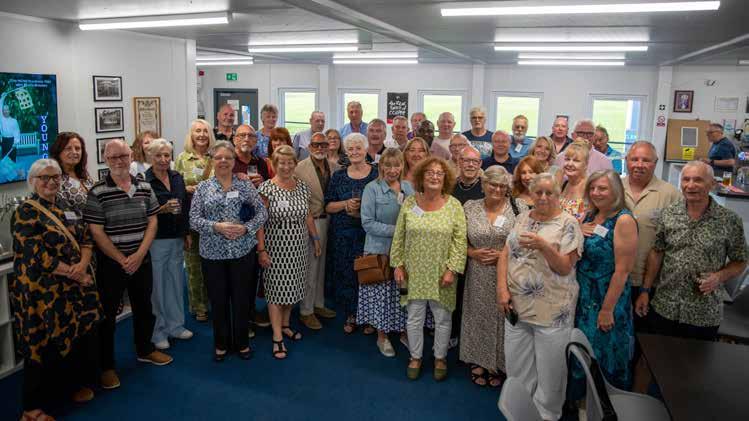

Written by Liz Gibbons
Sally McDonald (née Trett)
When the Class of ’75 came together for their 50year school reunion, it was a milestone for all, but especially for those seeing each other again for the first time in half a century. For Sally McDonald (née Trett), reunions mean far more than just a night of nostalgia. “The 50-year reunion is the third I have helped organise,” she explained. “I think reunions are undoubtedly great fun, but also an important reminder of our roots. It has been wonderful to celebrate old friendships, re-establish links and ultimately remember the ties that bind us.”
Some of those ties stretch back decades. When Sally moved to Thetford in 1965, her neighbour was Rhonda Johnson (née Bailey). The two girls went through Queensway Infant, Junior and Staniforth Upper schools together, later attending N.O.R.C.A.T., and today their friendship has spanned more than sixty years. “With some friends, you just naturally pick up where you left off,” Sally said. That bond carried them through years apart, Rhonda as the wife of an ex-Warrant Officer, Sally rooted

in Thetford, and eventually back into the shared role of reunion organisers. “It has been great fun, sometimes frustrating but mainly rewarding, tracing ex-pupils and organising the last two reunions with Rhonda,” she added, “always accompanied by plenty of reminiscing, and compulsory refreshments.”
Sally’s circle of school friends has remained strong. She still meets regularly with Jan Selley, Lorraine Emeny and Jan Young, friends who, like her and Rhonda, began their journeys together as fiveyear-olds at Queensway. Over the past ten years, the group has kept up regular lunches, now more frequent than ever. “Being friends for so long means we are totally at ease with each other and are always there to support one another,” Sally said. “At heart, we’re still those same five-year-olds, and we never seem to run out of things to talk about.”
The wider reunions, too, have forged new connections and encouraged mini meet-ups, over lunch, coffee, a pint in the pub, or even just a wave in town. They have also inspired people to travel back


to Thetford from Scotland, the USA, and across the country. “It has to be a great indication of what the reunions have meant to us all,” Sally reflected. Just as importantly, they have provided moments to remember and celebrate classmates no longer with us.
For Sally, these gatherings are about more than looking back. They are a celebration of the years that shaped who and where everyone is today.
When Rhonda moved back to Thetford after years away, she thought many of her old school connections were lost. That changed at the 25-year reunion, where she was delighted to reconnect with so many familiar faces. “It was such a joy to catch up with old school friends after so long,” she recalled. A chance meeting years later provided the spark for another gathering. In June 2024, Rhonda was at a pub charmingly called Five Miles from Anywhere No Hurry Inn. Just as she was about to leave, she heard someone call her name, it was Lynne, an old school friend. “We should have another reunion,” Lynne suggested. The idea stayed with Rhonda. That very night she messaged Sally, and together they began planning what became the 50-year reunion. Tracking down classmates proved challenging, especially the women, whose surnames had often changed. Facebook, Genes Reunited, and even the electoral roll were pressed into service. One of the hardest parts was discovering how many classmates had sadly passed away. Still, on 19th October 2024, around 50 people gathered in Thetford, filling the room with laughter, stories, and memories. By the end of the night, everyone was already asking about the next milestone gathering. Family and career have shaped much of Rhonda’s journey since school. She married into the Army, moving to Germany and adjusting to life away from family and friends. “I really struggled at first with the accents and sense of humour,” she admitted




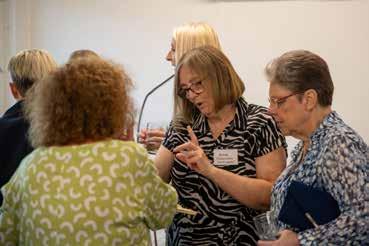

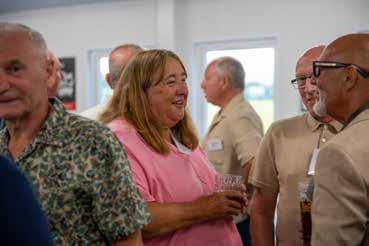
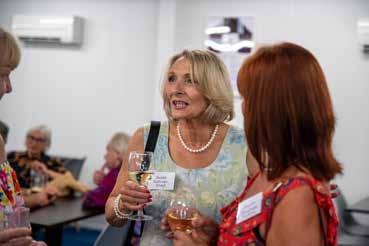



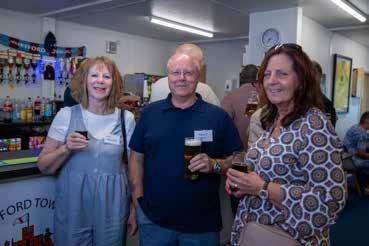
of her husband’s Liverpool and Manchester battalion. Rhonda still adapted quickly and built friendships that have lasted a lifetime. Back home, she worked for Ford for over 30 years, eventually becoming Group Business Systems Manager with responsibility for 54 dealerships across the UK, Ireland, and the Channel Islands. Her proudest achievements, though, are her two children: Amy, now living in Dublin with her teenagers Harriet and Charlie, and Adam, who lives in Thetford with his young boys Tom and Sam.
School memories bring both laughter and a touch of drama. She recalls a terrifying science experiment gone wrong when a mixture exploded, splashing acid onto her face and uniform. “No one even contacted my parents,” she laughed, “so you can imagine their shock when they got home to find me with half my face burnt!” Thankfully, only a small scar remains. Not all memories were so serious: on cross-country days, Rhonda and friends sometimes slipped into her house in Pine Close, waiting until most of the runners had passed before rejoining the course. On one occasion, she rejoined too soon, finishing near the front, and was promptly selected for the county team!
Like many, Rhonda looks back on the 1970s with a smile. A devoted ‘Bay City Rollers’ fan, she remembers wearing tartan-trimmed outfits to concerts. She also loved her Oxford trousers and Crombie coats. Discipline at school, though, was far less light-hearted. “Most of the boys admitted to receiving the cane or slipper from Mr. Briggs or Mr. Hull at some point,” she said. “There was definitely a stronger sense of discipline and respect for teachers back then.”
Reflecting on how the world has changed, Rhonda sees her generation as one that has adapted to extraordinary shifts. “We grew up without the internet or mobile phones, and now both are part of everyday life,” she said. She also values how society has opened up around issues like equality, diversity,

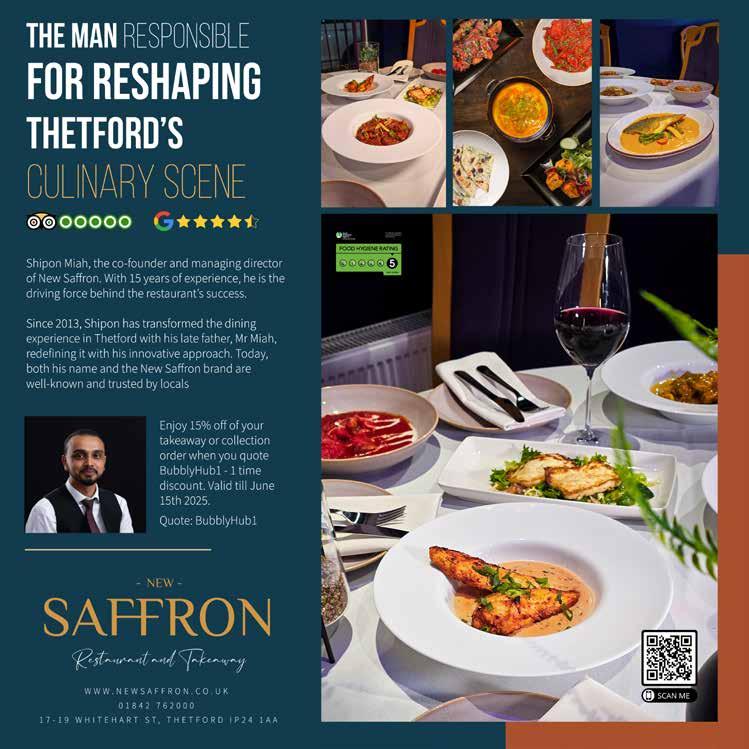
and mental health, things rarely spoken about in their school days.
Above all, she feels grateful. “It’s been truly wonderful reconnecting with so many old friends after all these years,” she said. “The friendships we shared back then have taken on new meaning now, there’s something really special about picking up where we left off, but with the perspective and warmth that comes from experience.”
Alongside the evening itself, a short questionnaire was sent out ahead of the reunion. The replies received give a fascinating glimpse into the lives of classmates since leaving school. One respondent, who wished to remain anonymous, shared a story filled with travel, sport, and unexpected turns. When asked if he married a classmate, he revealed that he did not but in fact married a girl from a younger year. Together they raised two children and now enjoy two grandchildren. His career took him into transportation and shipping, working in countries across the globe. “I gained confidence and worked in a number of countries,” he explained, recalling highlights such as time spent in Kuwait. Alongside his career, sport played a central role. Twice East Anglian karate champion in the 1980s, he also taught the discipline, eventually being invited to run classes at UEA and Wymondham College. He captained the university rugby team, too, and remains proud of having pursued education through night school to achieve his goals. In retirement, he’s discovered new skills, enjoying cooking and gardening.
When asked about his school memories, he recalls “the cane on a number of occasions” and the prediction from a teacher that he “wouldn’t make anything” of himself, something he’s clearly proved to be quite the opposite. His favourite teacher, though, was remembered fondly: “Mr Llewellyn, by a country mile.”
Reunions, he said, were a chance “to see everyone”, though he admitted he had not stayed in touch with school friends over the years and no longer felt deeply connected to his hometown. Yet, looking around at the gathering, humour and fun were the strongest emotions.
Looking ahead, he hopes to keep travelling, Japan remains high on his bucket list. “I love the clothes, cars and music of the ’70s,” a reminder that some passions never fade.
Janice Butler (née Selley)
Janice reveals that she never dated anyone from school and has no children or grandchildren, but her life since leaving has been full of change and achievement. She married, studied for a Business Management degree, and enjoyed a career in financial accounts, office management and international credit management. She is especially proud of how her studies helped her rise through her profession, and of the home she and her husband owned in Spain for 11 years, mortgage-free, before selling it so she could retire early.
Travel has featured strongly in her life, with cruises and holidays in many countries, but her most unusual passion has been exploring graveyards as part of three decades of genealogy research. She jokes: “I investigate dead people…!” In retirement, she has embraced new skills and hobbies, from woodworking, quilting and ornament restoration to photography and gardening. “Driving hubby mad with my obsession with all things wood,” she laughs. School memories are mixed. She recalls being taught to swim by a stand-in teacher in the last term and admits she was often the target of bullying: “I was the very shy, quiet, tall, skinny kid that everyone sniggered at. Now I am much more self-confident and often seen as quite gregarious.” She still meets up with three school friends every five or six weeks, though she has tried in vain to reconnect with two others.


•
•
•
•
•
•




Reunions, she says, are a chance to “reminisce and rekindle friendships that could, or should, have continued after school years.” While she disliked much about school at the time, she now finds joy in seeing classmates again, both the “nice” ones she remembers fondly and in overcoming her “long-held dislike of the nasty kids.”
Looking back, Janice believes her generation had more opportunities than those before them, though she laments the decline in self-respect and respect for others since school days. Looking forward, she wants more of what she has enjoyed since retiring: time to enjoy life, recoup her pension contributions, and tick a few more things off her bucket list, like riding a jet ski and mastering a dovetail joint. Her message to classmates is simple: “I disliked school and many of its pupils, but here I am; loving the reminiscing which makes me appreciate my own journey and where I’ve ended up. I do hope many of you can say the same.”
As the evening drew to a close, it became clear that this reunion was more than just looking back, it was about strengthening ties for the future. “One of the loveliest outcomes”, Rhonda reveals, “has been the creation of a Facebook group, Staniforth Class of 1975, where classmates can continue sharing stories, photos, and memories.”
Reunions remind us that while time may have passed, experiences and bonds formed in our childhoods are a part of who we are. Whether through laughter over old stories, remembering those no longer with us, or simply exchanging a smile across the room, each moment has shown how much the Class of ’75 still means to one another.
So, here’s to friendships old and new, to the memories that shaped us, and to the chapters still to come. Until the next time, cheers to the Class of ’75!

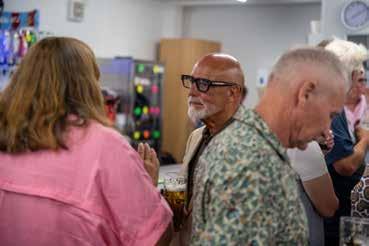



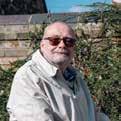
Photography, high jinks and words by Bob
Blogg

Firstly: The Medusa Trail
Afew issues ago, we took our mobility scooters on a road trip to Warren Lodge to test their off-roading abilities and just to see if we could get into the forest by that route.
We could! But far from fulfilling our wanderlust, it has just cranked it up.
Right, we decided, these sissy cyclists have got their routes in the forest, so why can’t we have one for our mobility scooters?
They have got the Shepherd Trail (green), graded easy, suitable for families and kiddies; the Beater Trail (blue), graded moderate, a basic mountain bike track with the odd tree root in the way; and the Lime Burner Trail (red), graded as difficult, featuring dropoffs and rocks, and not suitable for child seats and tagalongs.
Pah - amateur stuff!
We created the Medusa Trail (purple) for mobility scooters, graded as insane, and featuring grass, gravel and bullets.
Also, where all the cycling trails at High Lodge just go around for several miles in boring loops, we go to the pub!
We start at Warren Lodge, duck around the Thetford Rifle Range and onto fire-road 7 and out at the B1106 and into Elveden.
It’s just under 5 miles, according to the maps we looked at, and do-able on scooters as far as we could tell according to Komoot, the route planning app for hikers and cyclists. The only uncertainty is the exit at the end of fire road 7.



We can’t be sure if our scooters will squeeze out onto the B1106 until we try.
So, without further ado, we set off from Warren Lodge on our grand adventure, having got there by whizzing over the A11 with such familiarity that it was almost like a daily commute.
Our scooters got up the hill, across the sand and into the forest at the hurry up.
We then settled in for the first part of our journey: a straight drive down the path from the Lodge to the entrance to the Thetford Rifle Range. At least that’s what it was according to the Map.
This section was about a mile along a wide avenue with dappled shade, criss-crossed with the odd cycle path and smaller trails.
We had to make a slight detour when the path reached a fenced-off area that forced us to turn right and zig-zag for a bit, but we safely reached the rifle range with my camera only falling over once!
From there we set off alongside the rifle range on fire-road 10. This section is a gravel sea and very noisy.
It eventually reaches the Shepherd Trail cycle route and becomes much quieter and grassier.
From there we pressed on, and at one time we reached the junction of fire-roads 9 and 12. It was the first, and probably the only time that we knew where we were in the forest!
We then had a drag race, and we now know for sure which of our mobility scooters is the fastest. One of us is not a very happy bunny!
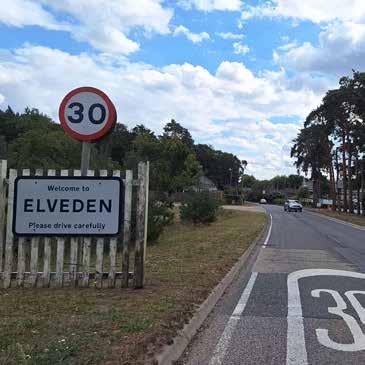



After all this excitement, we got lost and went for the best part of a mile in the wrong direction.
Eventually, we pulled ourselves together, found fire road 7 and escaped onto the B1106. We then raced down to the Elveden Inn and had a well earned beer or two.
It is a hell of a trip. If you are adventurous and up for a challenge, I strongly recommend that you try this route.
You are out in the middle of nowhere, exploring new grounds, and with no real idea where you are. It’s true escapism.
The tricky bits are just getting to the start point at Warren Lodge and the end point at the Elveden Inn. These are the road sections and they require confidence and certainty.
The forest is the orangey bit in the middle – so go for it!
Scan the QR code below to explore The Medusa Trail


Tiglet, my faithful boot scooter, had a ‘Doctor Who’ moment and has been reborn.
He got a bit tired of all the abuse he was getting so, after his last journey to the museums in London, he decided enough was enough. His batteries were faltering and his wheels were weary. It was time for a change.
With a big grin, he morphed into a full-on T-Sport X05 Auto-fold mobility scooter!
And what better way to celebrate his rebirth than having yet more Thetford retail therapy.
Anyway, as a birthday present, I wanted to get him a cup holder so off we went to Halfords.
Halfords is a great shop to take your mobility scooter into. The entrance is easy, even on a big scooter, and the aisles are quite wide. The only down side is the bicycle section.
It’s upstairs and there is no lift, escalator, or funicular railway option – yet!
The staff told me they hope to have a lift sometime in the future.The good news is that I did find him a cup holder.


Next on my shopping list was a chew toy for my friend’s dog, Paddy.
And, conveniently enough, Jollyes is right next door to Halfords.
Still sitting dreamily on my reinvigorated Tiglet, I went to get the dog a bone so to speak.
I soon ran into a problem: Jollyes have got a great big, wide, automated door, like Halfords, but they haven’t got direct wheeled access.
They have got a gigantic kerb in the way and car parking right in front of the door?
If you want to get in, you have to squeeze onto the narrow strip of paving either on the left or right of the doorway.
To further hinder you, there are shopping trolleys on the left and flatbed trolleys on the right.
Alternatively, if you have a good road scooter, you can just ram-raid the kerbed entrance, providing there isn’t a car in the way!
However, I did make it into the shop eventually. Once you’re into the shop there is plenty of room to drive around on a mobility scooter, even a road scooter. It’s a great fun shop to run around’ A toy shop for pets, well their owners really, and I got Paddy a peanut butter rubber bone!
Next on my shopping list were chips. I wanted frozen microwave chips because I’m lazy and I haven’t got a chip pan.
And next door to Jollyes is Farmfoods.
The first thing to say is that Farmfoods hasn’t got an
automated door. They have got two narrow doors, and one was bolted closed. Tiglet had terrible trouble getting through the door and it was through the help of a customer, who unbolted the second door that I managed to get in.
Secondly, there is the same access problem as Jollies before you even get to the door: A big kerb with cars in the way; and shopping trolleys blocking the narrow pavement.
Once inside the shop, you can get about the aisles alright on a little scooter, but you certainly couldn’t get a pavement scooter around.
The bad news also was that they had sold out of my favourite brand of chips, so I had to have a healthy lunch!
So, come on Jollyes and Farmfoods put a ramp on the kerb outside your front doors. It’s not rocket science, it is called common sense.
My Lucky Rat I have just got a last minute thing to add – it’s not really retail therapy. I wanted to tell you about my lucky rat!
A few weeks ago a huge rat invaded my flat. I was terrified. It was running around eating everything, including my window frame. I think he ate himself out of house and home in the end.
My landlord came around and rebuilt the frame and we got talking. He told me about the Pressreader app that Thetford Library gives you access to, so that you can read newspapers and hundreds of magazines online for free.
As a result, I was reading the New Scientist magazine (which I love and always used to read when I worked
for the BTO) when I saw the New Scientist Live 2025 event advertised.
It’s my seventieth birthday next month and thanks to that rat and Thetford Library, I am now going to the event at the Excel Centre in London. Thanks Ratty.
Shopaholics, scan the QR code here for a quick fix! The X5 Files and Retail Therapy

Finally: High jinks at High Lodge.
Right! It’s easy everybody said.
Phone up High Lodge and book their mobility scooters for the day.
And, as my antipodean friends would say: ‘no wucking furries!’
They mucked it up big time.
We got there at 12; they said we were expected at 9; we said we had booked 2 scooters from 12; they said we had booked them from 9 until 12, we said can we have our scooters please?; they said no you can’t; we said why not?; they said because you’re late so you

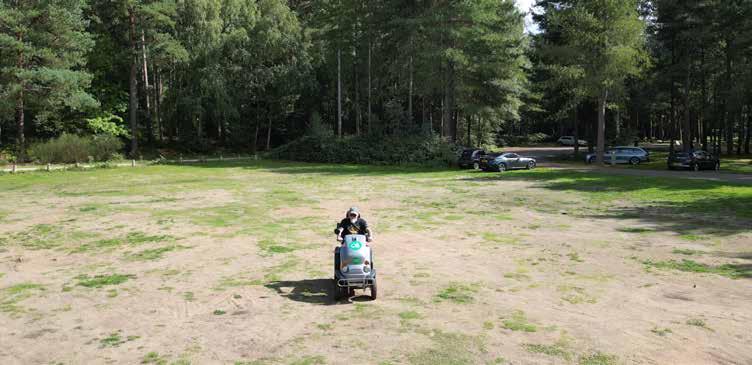
can only have one; we said you couldn’t organise a p£$$%% in a b£$%^; they said sign here...
So we did.
Now let me clarify things.
We had phoned up High Lodge and arranged to hire their two mobility scooters for the day a while ago. It was arranged and timed.
We had done it two weeks in advance because we wanted both scooters and we were told that would ensure the deal. I had even spoken to them a few days prior to that because someone else had phoned me up asking if I had had a response to the query that I had left on their answer phone a fortnight or so ago?
That should have rang an alarm bell!
That’s why we only had one scooter.
We knew their second scooter was a TGA Breeze S4 just like Adrian’s – so no big loss there!
But the other scooter was/is (never too sure about grammar tenses) a MK2 Tramper.
This is a serious, no nonsense, off-roading mobility scooter used by farmers and the like.
It even has bull-bars for heaven’s sake!
Me and Adrian just wanted to get our hands on it and give it a serious test drive.
Anyway, we did get our grubby hands on it eventually but not quite how we envisage.
We couldn’t follow each other around and one of us




NMV Sweet & Savoury
& Desserts

At NMV Sweet & Savoury, we create stunning wedding cakes, birthday cakes, and custom cakes for any occasion. Our menu also includes French mousse mini cakes, desserts, and appetizers, perfect for adding a touch of elegance to your celebration. Delivery available.
Visit us online: www.nmvsweetandsavoury.co.uk
Follow us on social media: Facebook @nmvsweetandsavoury
Instagram @nmv_sweetandsavoury 07936 612846

had to sit and watch while the other was racing around.
You can see Adrian having fun and watching in the photo below!
Despite all that, the Tramper is a serious piece of kit. It is one of the best built, most robust and strong mobility scooters I have ever seen. Its ground clearance is huge – you could drive it over a large sack of potatoes.!
The wheels are enormous, its footplate is solid metal, its lights are big and bright, and its controls and dashboard clear and easy to use.
We were severely limited with how we could test it because we couldn’t follow on another scooter. So we did the next best thing and drove it straight across all obstacles from our position in the car park to the information point in High Lodge. It didn’t miss a beat.
So, how fast is it? We have no idea. High Lodge or Forestry England to use a broader term has done their best to cripple it.
The Tramper is a beautiful mobility scooter, one of the best that Adrian and I have ever seen, and will do 8mph minimum and more probably.
The lame beast we hired in the forest could barely make 1mph. We suspect this is partly because of health and safety, and mainly because of the fear of litigation.
The MK2 Tramper is a phenomenal mobility scooter, it needs to be delimited and let loose, and I want one.
Scan the QR code on the right for some high jinks at High Lodge.
Happy Scootering!



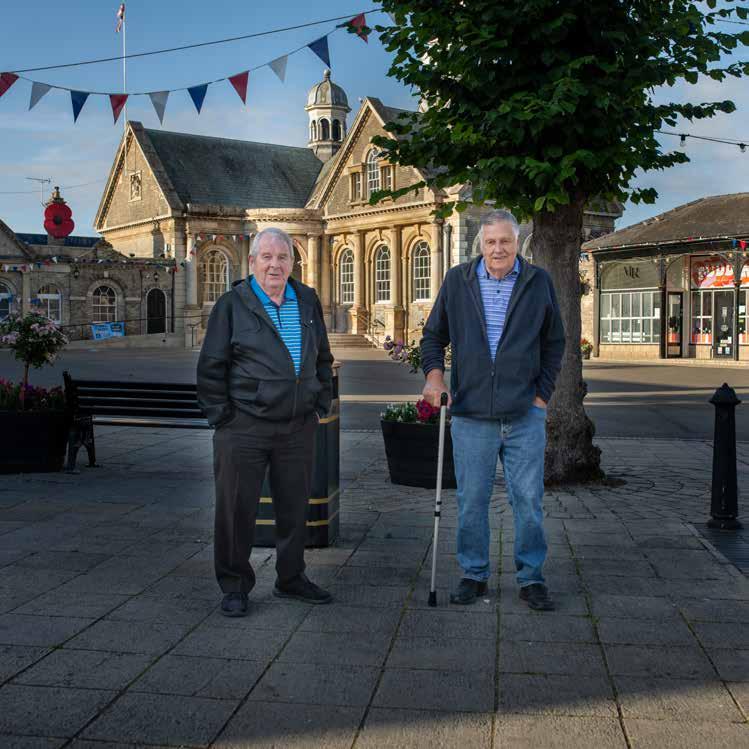

Written by Martin Angus
Every morning, except Sundays and bank holidays, if you walk through Thetford’s market square you’ll see them. Two old boys, side by side, watching the world go by. They’ve become such fixtures that strangers notice their absence before their presence. “If one of us isn’t there,” Trevor Kenny chuckles, “folk come up and ask if the other’s dead.”
They laugh, but there’s truth behind the joke. Thetford’s heart beats a little differently without Trevor and Graham posted up on the corner. For over seventy years, the two have been inseparable. Born in Thetford in the mid-1940s, they met at Norwich Road School in 1950. “We used to look at the old buggers standing on the square,” Graham admits with a grin. “Now we’ve become them.”
This is their story—and through it, the story of a town.
Who Are Trevor and Graham?
Trevor Kenny was born on St Margaret’s Crescent, just off Bury Road. Graham Fayers first saw daylight on Wells Street. Both are 80 now. They’ve watched Thetford change in ways that would astonish anyone who only knows the town of supermarkets and bypasses.

When they started school, there was only Norwich Road unless you passed the eleven-plus and went to grammar. Thetford was smaller then, tighter-knit. “Everybody knew each other,” Trevor recalls. “And if anything went wrong, everyone knew about it.” The market square was the heart of it all.
Over the decades, they’ve seen buildings rise and fall, pubs turn to flats, and the old dances disappear. But they’ve stayed. “There used to be more of us,” Trevor says. “My brother, Tommy Peck, John Waldron… they’re all gone now. Two big ones gone. Now it’s just us.”
In that loss is part of the reason they stand there.
The question everyone asks: why do two octogenarians make the daily pilgrimage to the same spot? The answer is deceptively simple.
“If I don’t come,” Graham says with a mischievous glint, “my family think I’m dead.” It’s partly a joke, partly true. Their daily presence is a check-in with the world.
“You’d be surprised how many people we see every day. Same faces. Some we don’t even know their names,



but they stop and talk. Ask after the other if one’s missing. Where else are we going to go? You can only go shopping so many times.”
They stand there to watch life unfold: kids on their way to school, shopkeepers setting up, tourists lost and asking where Castle Hill or Dad’s Army museum is. “We’re like unofficial tourist information,” Trevor says. “We’ve probably made that museum a fortune.”
They stand there for the laughs too: “We’ve seen a big blow-up screen for the King’s Coronation take off in the wind, a leaf-blower chasing the same leaves in circles, lorry drivers asking directions to streets they pass every day. You couldn’t make it up.”
And maybe, most importantly, they stand there because someone has to bear witness to the life of the town. “We see the town going downhill,” Graham laments. “Very fast. We talk about what’s happening, what’s not happening. The memorial’s been without its chains for nine months. People walking over it. No respect. We notice these things.”
The Market Square as a Stage
Listen to Trevor and Graham long enough and the square comes alive as a theatre. They recall fights outside the Angel and Dog & Partridge when paratroopers came in on Saturdays. They remember where they were sitting when news of JFK’s assassination reached them—in the window of the Red Lion pub.
They point out where Mrs. Ellison sold sweets out of her front room, where the red phone boxes stood, where “Dinger Bell,” the local bobby, kept watch and occasionally pulled a prank. They laugh about the sergeant who barked at Graham to “get in that gutter, son,” and got a dressing down from Graham’s dad. It’s more than nostalgia; it’s living memory of a town that has always been in flux. They’ve seen London overspill families arrive in the late 50s and early 60s, worked at
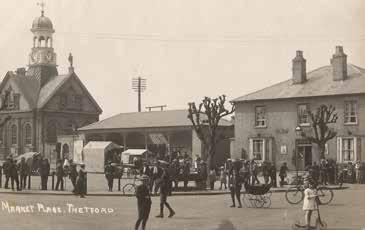
The corner of Thetford Market square has a long history of being a place of social gathering.
Photograph circa 1920, from The David Osborne Collection - by kind permission of Joy Osborne.
some of the factorys who employed hundreds, locals and migrants alike side by side. They’ve watched small shops disappear, replaced by empty flats and chain stores. They grumble about Amazon hollowing out the High Street and banks closing branches. “They don’t want people like us. We ain’t got any money any way,” Trevor shrugs.
But for all their complaints, they remain stubbornly, lovingly present.
A Social Lifeline
Trevor and Graham aren’t just passive observers. Their corner has become a social hub, a lifeline not just for them but for others. A Polish girl newly engaged stops by to share her news. A Turkish couple bring them smiley faces. Children wave from across the street.
“We talk to everyone,” Graham says. “Little foreign kids born here, old locals, tourists. It doesn’t matter. If you



01842 683292
2 Bridge Street, Thetford, IP24 3AA instinctively_mystical@yahoo.com www.instinctivelymystical.co.uk
stop, you get a word.”
They offer directions, history, jokes. They notice what others miss. They know when the leaves are being blown in vain, when a painter has fallen off a ladder, when a tree clogs the river under the iron bridge.
They are also keepers of the town’s oral history. Ask about Pall House, and they’ll tell you they’ve lived here 80 years and never seen it. Ask about the old Guildhall dances, and they’ll describe hundreds of youths gathering every Saturday night for live bands. Ask about sweets, and they’ll tell you which shopkeeper gave the biggest ha’penny worth of blackjacks.
In an age when social life is increasingly virtual, their routine is quietly radical: showing up in person, day after day, for uncurated, unmonetised human contact.
What Thetford Has Lost—and Gained
Talking with Trevor and Graham, you hear a familiar refrain: the town isn’t what it used to be. They miss Savages department store, the shoe shops, the pubs, the sense of everyone knowing everyone. They complain about empty flats, absentee landlords, and council delays.
But they’re not blind romantics. “You hear kids say there’s nothing to do,” Trevor says. “What did we have? We swam in the river. Got covered in cuts from the weeds. We made our own fun.”
They acknowledge that life has always been hard here and that not all change is bad. Immigrant families are part of their daily landscape now; they greet them with the same warmth as any local. They still see grandchildren and great-grandchildren. There’s pride amid the grumbling.
Their criticisms of the town council, of modern consumer habits, of civic neglect come from love. They want
Thetford cared for. They want its history remembered. They want respect shown to its memorials, its people, its past.
Why does their story matter? Because in an era obsessed with speed and novelty, Trevor and Graham practice the slow art of noticing. They know which shop has been empty for two years. They remember when the safety deposit place was built and what Captain Knopper dug up in the process. They know the names of coppers and barmen from sixty years ago.
And they’re willing to share it—with anyone who stops to ask.
Their presence raises deeper questions about how communities remember themselves. When the last old boys leave the square, what stories will be lost? Who will point out where the caravans were made, or who hid in the trees to catch kids, riding boats to fires? We often complain about social isolation among the elderly, yet here are two men who have made themselves available, public, connected. They are living antidotes to loneliness. And the community responds: tourists asking directions, locals stopping for a chat, kids shouting hello across the street. It’s easy to dismiss them as “characters,” but they are more than that. They are guardians of memory, unintentional civic ambassadors, and a daily reminder that public life isn’t confined to official institutions.
Ask Trevor and Graham about Thetford’s future and they don’t mince words. “I’m glad I ain’t going to be here,” Trevor says. He worries for his grandchildren growing up in a world of empty shops and online everything. But there’s a shrug of acceptance too. “Them days are gone. No chance of getting them back.”
They may be right that the old Thetford—of Savages and Guildhall dances, of Dinger Bell and blackjacks—is gone

for good. But perhaps the future doesn’t need to look exactly like the past. Maybe it just needs more of what Trevor and Graham practice every morning: presence, connection, care.
Their routine offers a quiet lesson. Communities aren’t built by development plans or nostalgia alone; they’re built by people showing up, paying attention, talking to each other. Even when the news is bad, even when the shops are empty, even when you’ve “been round the circuit” as many times as an octogenarian can.
You don’t have to live in Thetford to recognise the pattern. Most towns have their Trevor and Graham: the pensioners on the bench outside the Co-op, the women nursing tea in the café window, the dog-walkers swapping gossip at the park gate. They are the informal social glue of communities.
Yet their contributions are often invisible until they’re gone. We underestimate the value of local knowledge, of watchful eyes on the street, of someone who notices when you’re missing and asks if you’re okay.
Urbanists like Jane Jacobs argued decades ago that the “eyes on the street” keep neighbourhoods safe and alive. Trevor and Graham are proof. They may not intervene when smoke comes from the post office—they wait for the fire brigade—but their very presence deters and reassures.
They are also living archives. Oral histories like theirs— funny, unfiltered, sprawling—are the connective tissue between past and present. Without them, towns risk amnesia.
To understand the magic, spend a morning with them. They’ll point out the tree clogging the river, tell you
where to get the best bacon roll, introduce you to every passerby with a quip or a complaint. They’ll recount how as kids they mocked “the old buggers” on the square, and how the cycle turns.
They’ll give you directions, not just to Castle Hill but to a Thetford of memory: where the soldiers fought, where the dances swayed, where Mrs. Stern’s sun blind once swung under the weight of mischievous boys.
You’ll laugh. You’ll shake your head. You might feel a pang for what’s gone. But you’ll leave feeling more connected— to place, to time, to people.
Holding the Square
As our interview winds down, Trevor sums it up: “We’ve been coming here all our lives. We’ll keep coming till we can’t. It’s what we do.”
And that’s the heart of it. Two old boys standing on a corner may not seem like much. But in their steadfast presence is something towns everywhere need: continuity, memory, a touch of humour, and a lot of heart.
They remind us that a market square isn’t just a place to buy and sell; it’s a stage where life unfolds, where histories intersect, where human beings meet.
Next time you pass through Thetford, look for them. If they’re missing, ask after them—they’d do the same for you. If they’re there, stop a moment. Ask what’s new. Ask what’s old. Ask about Dinger Bell or the Guildhall dances or the day the big screen blew away.
Listen. Laugh. Remember. Because Trevor and Graham won’t stand there forever, but as long as they do, they are holding a space for all of us—a space where community still means standing together, watching the world, and saying hello.



Written by Martin Angus
In 1983, with Margaret Thatcher in Downing Street and more than three million people out of work, a grammar-school sixth-former sat in assembly in a Norfolk market town and listened to a teacher named Mr Hardwick make a simple announcement: Witton Chartered Surveyors had a vacancy for a junior negotiator. The boy—18, unable to drive, raised in local authority housing and with no family history of buying or selling property—took a lift to the interview. He got the job. The weekly wage was £45. And he openly admits that “absolutely nothing” drew him to estate agency, other than circumstance.
That boy, Yannis, would go on to spend forty years selling, surveying, arguing, consoling, measuring boundaries in the rain, and, just as often, holding his tongue until the people in front of him felt heard. Along the way he bought the firm he’d joined, rebranded it Chilterns, expanded, endured the crash of 2007, outlasted every fad in the portals era, and this year made the hardest call of his career: selling the business

that had become synonymous with his name and the town’s high street. What emerges from his story isn’t nostalgia. It’s a quietly radical proposition about what estate agency is for, and who it should serve.
This is not the tale of a “property guru” or a hyperscalable disruptor. It’s a portrait of a craft that became a calling—shaped by a mentor with a theodolite, a town that measures worth by trust more than by valuations, and a proprietor who believes service is a moral category, not a marketing claim.
The apprenticeship that wasn’t meant to be The early 1980s trade on property folklore as the decade of deregulation and Right to Buy. But Yannis’s initiation began not with boom-time bravado, but with the sober discipline of a small professional practice. Estate agency back then, he says, “sat on the foundation of professional firms of chartered surveyors.” He learned the business beside Alec Witton—“very professional, extremely principled… a

mentor, almost a professional father.” While some peers rattled off particulars, he was outside with range poles, staking boundaries, and learning scale drawing at 1:500 and 1:1250.
To grasp why that matters, consider what a Chartered Surveyor represented to lenders, lawyers and buyers: sober, recognised opinion. Not sales patter—judgement backed by method. Even for a junior who “had no idea what an estate agent was,” the work’s centre of gravity was evidence. Mortgage valuations for building societies, structural surveys that called in engineers and electricians when needed—this wasn’t the era of instant uploads and “guides” that blurred into fantasies. A surveyor’s sketch had legal weight. A missed crack had consequences.
Yet the other half of the craft was—and remains— people. “Selling a house isn’t rocket science,” Yannis says. “It’s about communication, connection, trust.” The seller pays the fee, but the buyer’s trust is often the thread that pulls a chain through to exchange. The art is holding both ends of that thread without snapping it.
Before Rightmove: pamphlets, papers, and reputations you could walk across the street to check. It would be easy to romanticise the pre-portal days. Yannis doesn’t. He remembers the graft. You placed ads in the Thetford & Brandon Times, the Bury Free Press, the Eastern Daily Press. If a couple from Essex were coming up for the weekend, they asked for pamphlets posted in advance, or joined a “mailing register.” People did their research in their sitting rooms, but it started with a phone call and the local paper.
There was less inventory on the market and fewer agencies on the high street. What there was, however, was a denser weave of relationship: you won instructions because a figure like Sandy Witton had been a professional presence in the town for years. You weren’t selling on an amorphous grid reference;
you were selling a house on Nunsgate or Nunnery Drive—places where the buyers’ cousins lived, where the neighbours recognised your for-sale board and, by extension, your reputation.
Today, everything begins online. The first ring into the office often arrives through a portal, badged on a dedicated number that announces itself as a Rightmove enquiry. The customer has already triangulated floorplans, EPCs, and Google Street View. That first hello is the tip of a pre-screened iceberg. For Yannis, the implication is less about romance lost and more about the moral obligation of accuracy. If the lounge research decides whether they call at all, then what’s online must be “as transparent as possible.” Buyers should arrive to a viewing informed, with “no surprises,” so they can focus on how a place feels, not on reconciling reality with a flattering lens.
The bigger change, in his telling, is cultural. “If I’m honest, it was more honourable,” he says of the trade’s earlier era—not because people were saints, but because agents spoke to each other, shared information to unjam chains, and valued service in a way that wasn’t constantly subordinated to “winning.” Competition today, especially in corporates, isn’t collegial rivalry; it’s a KPI arms race. The pressure rolls downhill: targets for viewings booked (regardless of suitability), mortgage referrals demanded as a price of a viewing, conveyancers forced into “bundles.” He won’t play that way. Offer alternatives? Absolutely. Mandate them? No.
If there is one theme he returns to with both heat and care, it’s pricing—and the way the industry incentivises self-deception. The typical instruction call, he says, masks two conflicting desires. In the vendor’s head, they want to know “the true value.” In their heart, they want the highest number. Some agents oblige with the oldest trick in the book: overvalue to win the signature, tie in the longest sole-agency contract, then “chip away” at

fortnightly intervals until price meets reality—by which time the instruction is sticky, the market is stale, and the relationship is frayed.
Yannis refuses the seduction of being “the most and the cheapest.” If he believes the evidence points to £250,000, he’ll say so. You can market at £275,000 if you wish—it’s your home—but you invited an opinion, not a sales strategy disguised as one. In his lexicon, there is a sacred distinction: the difference between *worth* and *launch plan*. Worth is an opinion rooted in comparables, condition and context; launch strategy is about how you create demand.
And demand is everything. Price too high and you don’t simply forego offers—you forfeit the very competition that creates your leverage. “If it’s too much, no one looks,” he says. “With one buyer after six months, the power is with them.” Find the *demand point* on the XY axis—his phrase—and you don’t “give money away”; you stage a contest. You empower the seller to say no—because there are alternatives walking up the path. The dishonesty he rails against isn’t optimism; it’s the weekly, unreasoned call to “drop the price” from the same agent who set it last week. “What changed in a week?” he asks. “Nothing—except their target.”
This is where his old-school training and people-first ethic dovetail. Pricing is not an algebraic formula; it’s an opinion applied to a story. A client on the brink of repossession has different needs than a family upsizing for a baby due in October. A “best price” for one can be a calamity for another if it arrives three months too late. Advice without context is noise.
The crash, the troughs, and the ballast of lettings Property isn’t a one-way escalator. Yannis came of age before the Lawson Boom, bought a business in 1999, and took the full brunt of 2007–08. “The challenge is to ride the troughs,” he says with the
matter-of-factness of someone who has. That requires more than temperament; it requires ballast. Lettings, often dismissed as fiddly, is for him the stabiliser that keeps an agency upright when sales are thin. The monthly management fees may look modest next to a completed sale, but in a drought they keep the lights on and the team employed.
He’s defensive of decent landlords, too—unfashionably so in some circles. Not because he romanticises the sector, but because he sees its arithmetic up close. Many of his landlords leveraged their homes to buy one or two properties, planned to pay off mortgages over decades, and now find themselves squeezed by tax changes like Section 24 (which removed mortgage interest relief) and the prospect of further reforms around possession. He’s not blind to abuses; he simply refuses to reduce the entire private rented sector to the worst headlines. “Decent private landlords have shored up the housing needs of this country for many years,” he says. If you drive them out, you don’t punish greed; you shrink supply, drive up rents, and make saving a deposit even harder for the tenants you thought you were defending.
The larger structural backdrop is the one everyone feels: affordability stretched to a breaking point, firsttime buyer ages drifting upward into the mid-30s, the private rental sector carrying demand once met by council housing, and a planning and delivery machine incapable of building at the scale required. He is blunt: “We’re just not building enough houses.” That’s policy talk, but for him it’s pastoral: the “lost” cohort stuck between staying at home and a private rent they can barely afford. Agency, at its best, can’t fix that. It can tell the truth within it.
An independent’s creed
Why, then, did he start his own firm? It wasn’t some heroic leap. “He retired,” he says of Alec Witton. Right place, right time. He took over in 1999, named the
business after the building—Chiltern House—because it sounded right for a head office. The name stuck, as good names do, less because of brand theory than because, after a while, nothing else feels possible.
What he built over the next quarter century wasn’t a cult of the proprietor; it was a team that shared a language: honesty, strategy, service. A community recognised itself in that language. The Brandon office, led by colleagues who started with him as teenagers and now hold the place with quiet authority, became proof of concept that you can run an agency where “it’s never about me.” The brand matters because it’s shorthand for the behaviour clients can expect when they walk through the door. And if you want to know what that behaviour looks like, don’t start with the sales ledger. Start at the Weeting Steam Engine Rally.
For years, Chilterns sponsored the three-day event, supplied the boards, and staffed a stall not to pitch listings—“you’re not going to sell houses at the Steam Rally”—but to run a tombola that raised thousands for East Anglian Air Ambulance. Staff volunteered their own time, canvassed local businesses for prizes, wrapped bundles, and worked the table in the sun. The firm donates to the mayor’s fund, sponsors girls’ football, and quietly backs the sort of small, unglamorous local efforts that make towns feel like home. “You shouldn’t do it for what you get out of it,” he says. “You should do it because they’re your community.”
If that sounds like sentiment, look again. It’s strategy of a sort—just not the game theory of click-through rates. In a world where every corporate promises “local knowledge,” the truly local put their money and their weekends where their mouth is. The return isn’t a guaranteed instruction; it’s trust banked over years. And when you need someone to believe you at £250,000 rather than £275,000, trust is the only currency that trades.


What clients don’t see—and why it matters
People also don’t see the cash-flow reality of agency. Almost everything the public touches— valuations, photography, portal subscriptions, petrol, staff hours, office heating—is paid up front by the agent. Fees arrive only when contracts exchange. If a sale falls through, the months of work vanish from the books as surely as if the phone had never rung. The industry trains the public to expect “free advice.” Other professions call that “consultancy.” In agency, it’s the cost of entry.
That is not a plea for sympathy. It’s an explanation for why he is ferocious about the quality of that free advice. If you’re going to carry the risk, carry it with integrity. “It should be fought on a professional level,” he says, not on the level of telling people what they want to hear to “win the business.” Integrity doesn’t mean inflexibility. It means clarity about trade-offs, and it means taking the weight when things go wrong. His staff, he insists, should not carry their work home like a second mortgage. If there’s a complaint, a confusion, a chain that’s knotted, the burden escalates to him. “I’ll always step in and confront it,” he says. In the long run, that’s not just humane; it’s commercial. Good people stay when they know someone will take the hard phone call.
On selling the business—and staying himself
Selling Chilterns, after 27 years, was “the single most difficult decision I’ve ever made.” Not because the market forced his hand, but because the decision was personal. He is, by his own admission, not a “ruthless” manager. He is a human one, and that means he structures a business around the lived realities of the people in it: a two-month trip someone needs before life narrows; a health scare that changes what “full-time” means; part-timers who, in three days, achieve more than some do in five. That elasticity is easier in a firm of a certain size; in larger corporates it hardens into policy. He chose,
for a long time, people over policy.
So why now? Age, a desire for more balance, a wife to consider, and a remaining challenge he still relishes: he continues to own and focus on Fine & Country in Bury St Edmunds, a smaller canvas on which to paint the next five years before a “proper retirement.” Selling Chilterns isn’t an exit from service; it’s a re-composition.
The staff surprised him with a barbecue to mark the change. He took it as confirmation of what mattered most: that the culture he tried to build—mutual support, straight talk, humour in the hard bits—took root in people, not just in a logo.
What would he tell someone starting today? His first answer—“Don’t do it”—is delivered with the wry smile of someone who knows he would do it all again. The real advice is nuanced. Seek out an independent if you can; learn the whole business, not a sliver. The corporate compartmentalisation of roles—valuers here, negotiators there, lettings over there—may suit spreadsheets, but it breeds one-trick ponies and advice that can’t see around corners. If you’re in front of a client who asks, “Should I let instead of sell?” you should be able to discuss yields, legislation, and pitfalls without fetching another colleague to finish your sentence.
He’s supportive of qualifications—Propertymark memberships, NVQs, the mooted Regulation of Property Agents (ROPA)—not as bureaucratic hurdles, but as a way of dignifying the craft and putting a baseline under competence. Yet he also insists that regulation will never replace the habit of going out to a new-build with a Land Registry plan, tape measure, stakes and a hammer, and actually *staking* a disputed boundary. That isn’t in the KPI pack. It’s in the marrow.
Gratitude that sounds like grit
Ask Yannis what he’s most grateful for and the answer comes haltingly, not because he’s searching for something to say, but because saying it pulls on threads most of us prefer to leave neatly knotted. He talks about the grammar school and how, in the 1970s, you either owned a house or you lived in a council one—but the kids wore the same scuffed shoes. No one had Nike. Appearances didn’t stratify you into brands. What stratified you was whether you let those invisible lines determine your horizon.
He remembers walking home up Bury Road, watching sixth-formers lucky enough to drive pull into school, thinking how extraordinary it would feel to take his mother shopping in a car rather than walk in the snow. Gratitude, for him, isn’t a sunset feeling; it’s the energy released when you refuse to be defined by beginnings you did not choose. It is gratitude for a work ethic that paid for driving lessons on £45 a week, that added pub shifts from six to eleven, that knew—without any grand plan— that survival can be a strategy until it becomes success.
He is grateful for having the *philosophy* that shaped that work: the refusal to romanticise, the willingness to go without, the understanding that “failure is a terrible thing in your mind” precisely because you know what nothing feels like. Many of us, he suggests gently, give our children the ease we didn’t have—and in doing so, accidentally take from them the fight that made the ease possible. He’s not blaming; he’s noticing. And he’s reminding himself, as much as anyone, that sacrifice sits in the ledger behind every apparently comfortable life.
He’s grateful for his family and for health that lets him keep going. Grateful for a town that gave him the chance to make mistakes, try again, and be known not by a billboard but by a thousand conversations
on doorsteps and in draughty hallways. Grateful, even, for the rough patches, because they proved he is, in his words, “resilient… pretty tough.” Gratitude, here, is another name for responsibility. It’s why he will turn up at Bury with the same tape measure he used in Brandon.
The case for old-fashioned decency in a data-driven age What should we take from four decades of a life that started by accident and ended—this chapter anyway—by choice? Not that yesterday was better. Not that corporates are villains and independents saints; both can be shoddy or superb. The editorial lesson isn’t a binary. It’s a call to recover a handful of unfashionable words and recognise how modern they are when lived with conviction.
‘Honesty.’ Not the weaponised kind that says “I’m just being honest” as a euphemism for rudeness. The kind that tells a vendor what the market will likely bear, distinguishes worth from launch plan, and then shows the courage to be proved wrong or right together.
‘Service.’ Not as a syrupy slogan, but as the discipline of doing the thing the situation demands—be that staking a boundary, or telling a buyer they really do need to speak to a mortgage adviser while resisting the urge to make it a condition of viewing.
‘Community.’ Not because charity is good PR, but because an agency is a community business or it is nothing. A tombola may not sell a bungalow, but it says something true about who you are. When people choose you to handle their largest asset, that something matters.
‘Craft.’ Not as a defensive crouch against technology, but as the human overlay that makes data meaningful. Portals, CRMs, and AI can tell you what sold. They cannot tell you why this particular couple must complete by mid-October, or how to sequence
viewings to let competition do your negotiating for you.
‘Responsibility.’ Not the heroic kind that seeks credit, but the unshowy habit of taking the hard calls off your team, and owning the mistakes that happen whenever human beings do complicated things at speed.
Yannis didn’t choose estate agency out of passion. He chose, again and again, to do it with decency. That may be the lesson here for the rest of us, whatever our trade: you don’t need a plan to have principles. You need the humility to learn from a mentor, the courage to speak plainly when it costs you the instruction, the patience to build a brand one conversation at a time, and the grace to let go when the time comes—knowing that what you really built wasn’t a company, but a way of working that will outlive your name on a fascia.
Forty years after a school assembly set him on this path, the industry he inhabits is barely recognisable. Affordability is stretched. Portals are the public square. Regulation tightens. Landlords feel besieged. Chains are longer, nerves shorter. And still, the essentials have not changed: houses are means to human ends, not talismans; truth told early saves heartache later; and trust—earned in inches—will carry a client further than any fee discount ever will.
There was never a plan. There was, instead, a town, a team, and a stubborn belief that the right way, though slower, pays compound interest in reputation. If we want an estate agency worthy of the communities it serves, perhaps that is the disruption we need: less swagger, more stewardship. Less theatre, more thinking. And a few more agents willing to say, with a straight face and a clear conscience, “It’s worth £250,000—and here’s how we’ll prove it.”

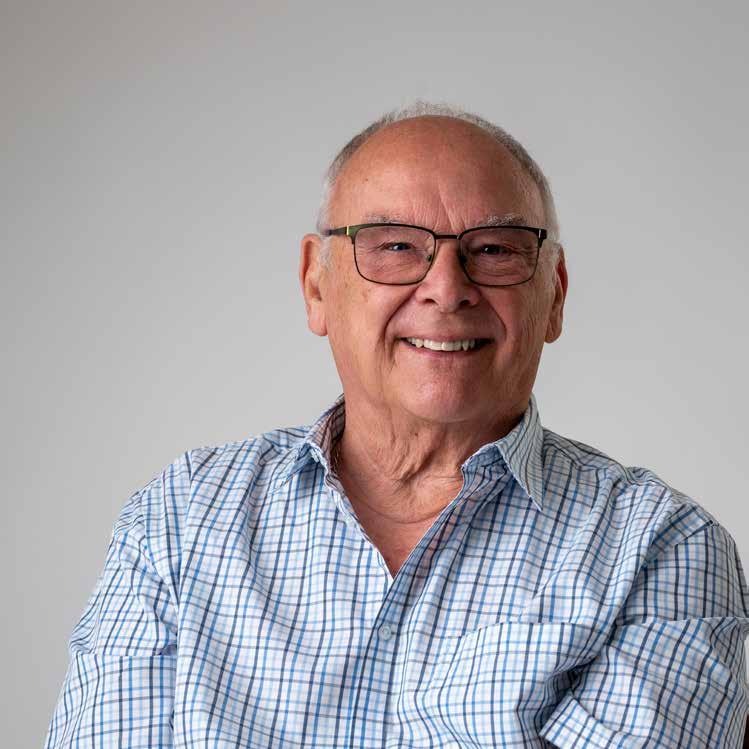

Written by David Williams
One of the things I like most about writing these pieces is that I get to meet and spend time with the nicest of people and another opportunity to do so came when I was given the commission to write about one of the first London Expansion scheme families to move to Thetford in 1959.
Ralph Mead and his wife made me most welcome in their lovely home, where all my interview questions went out of the window and we had a wonderful little chat (for about three and a half hours!) about, amongst other things, the subject on which I was supposed to be writing!
When penning this, the main topic I wanted to address was how the Londoners were received by the locals when they moved here; I had expected there might have been some hostility towards them, which had been my experience living in Stevenage

and Letchworth, where, when anything went wrong or missing, it was always blamed on the B. Londoners! But, no, everyone I spoke to has had the same response – they were very well received, especially as they brought with them jobs and a new prosperity for the town. The only real discord seemed to be over the disparity in wages, with the locals being paid a lower rate than their London counterparts, which led to local companies losing staff or having to increase wages to fall in line.
Post-World War Two Harlesden that Ralph lived in for the first thirteen years of his life into was very different to today; many older readers will recall homes with no indoor facilities, but younger readers might be horrified by the thought of having to leave the house to pay a visit to an outside toilet, unheated, so, freezing in the winter and unlit, with the only source of light a candle and the hope that on a windy night it did not blow out leaving you in

the dark. Obviously, with minimal indoor plumbing, their Victorian terraced house had no bathroom and although for Mr & Mrs Mead senior, the convenience of the public baths was only a short distance along the road, this was not a luxury so frequently extended to the children, except, Ralph recalls on the odd occasion being taken by his father. No, for them, the cosy ritual of the tin bath was the order of the day with them being bathed in the same water, taking turns according to age, Ralph being third in line, and hoping that their elder siblings had not been too grubby! To quote Monty Python’s four Yorkshiremen, “You try telling that to the youngsters of today and they won’t believe you”!
It so happened that the company Ralph’s father worked for, George Williams, were going to relocate to Thetford and the lure of a brand new four bedroomed semi-detached house with indoor facilities sealed the deal for the Meads. Ahead of the move, Ralph’s parents, Dennis (aka Danny) and Mary travelled by coach with other company employees to view potential new houses, pictured here with their daughter in the beginnings of their future home in Sweyn Close, along with George Williams himself and their future neighbours, Bill and Kitty Williams and Ernie and Blanche Farmer.
Picture here from local newspaper from Ralph Mead So it was that on 8th August 1959, that the Meads made the four-hour journey (no motorways, dual carriageways or by-passes then) in the removals van along with all their worldly possessions to become one of the first London Expansion scheme or “Overspill” families to take up residence on the new Barnham Cross Estate.
At 13 ½ years old, what was it like for Ralph starting a new life in Norfolk? Well after the hustle and bustle of North West London, he said it was very quiet and there was so much open space, the locals were
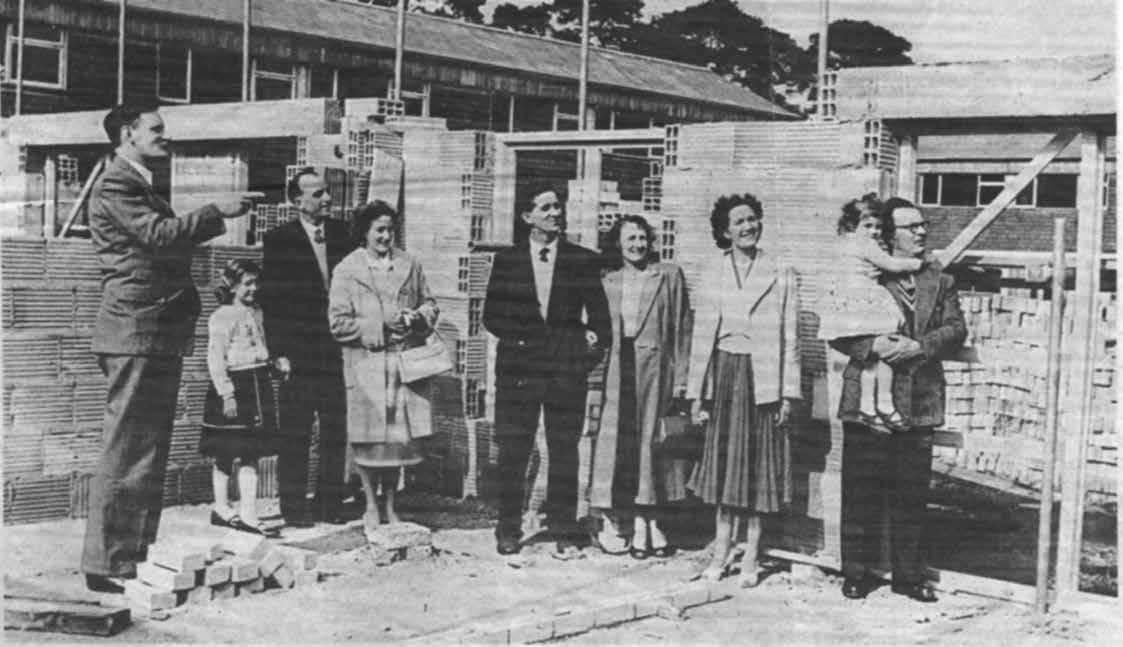
Sweyn Close, 1958, Mr Bill Jennings, Thetford borough surveyor, showing families from London their prospective new homes. Newspaper clipping submitted - unknown publisher

mainly agreeable, although in Ralph’s own words “The local boys were not so keen, but the girls were friendly towards me”! Taking this up, Teresa says that the girls had grown up with most of the local boys and regarded them as friends, but the London lads offered a more exciting and romantic prospect for them!
School for Ralph at Norwich Road, he recalls was educationally, a little behind the curriculum in London but he liked it well enough and was pleased that swimming lessons were included which he enjoyed back in Harlesden, though he was horrified the first day he went swimming with his new school in Thetford. Having been used to boarding a coach and being taken to an indoor swimming pool in London, he was now expected to walk across town to Nunns Bridges to an outdoor pool which was in fact just part of the river! Not that he was a stranger to what we now call wild swimming and had been used to dips on summer days in the Grand Union Canal which ran behind his old home in London – but this, as school swimming lessons? Really? At this time, he did rather think he had moved to the back of beyond!
A few months later, Ralph recalls, they all went back to Harlesden to stay with his aunt for Christmas and he took the opportunity to meet up with some of his friends, who immediately picked up on his accent which surely couldn’t have changed much in four months, could it? But they commented that he was “talking funny”! It is still apparent that Ralph has London origins though his accent is now tempered over the sixty-six years in Thetford. He also recalls that after only a short time away from the city, he had become more accustomed to walking - public transport in Norfolk being nothing like London with buses and underground trains, so for their trip to the cinema that evening when two buses had failed to arrive, Ralph suggested walking the short distance
but his friends were horrified at the prospect and would not hear of such a thing, so they stood and waited for a bus to eventually turn up.
At Norwich Road School, girls and boys were segregated so contact with the opposite sex was limited to either when waiting in the queue for school dinners (it wasn’t called lunch in those days!), asking the girls who had been in for the first sitting what was on the menu, or last lesson on Friday afternoons when they would come together for ballroom dancing lessons. Things changed when Ralph moved up to the newly opened Staniforth secondary modern school (now the Charles Burrell Centre), boys and girls attended classes together and Ralph recounts that loving school so much that he asked to stay another term. For him, school wasn’t just about academic achievements; being a keen athlete, Ralph excelled in many events on the sports field and achieved 11 standards, 7 advances, the school records for running the mile, half mile, quarter mile and one hundred yards as well as being a decathlon winner. Teresa recalls that when the time came for her to move up to secondary education, she was rather disappointed to pass her eleven plus exam which qualified her to go on to Thetford Grammar School, which was and ancient establishment with old classrooms and facilities –she would much rather have attended the shiny new secondary modern!
Eventually, having met at primary school and through mixing with the same friends, a romance blossomed between Ralph and Teresa and in 1968, they tied the knot; a wedding which Teresa recalls took only six weeks to arrange with a reception at the “Corner House” restaurant, now a Chinese takeaway in Bridge Street. Entertainment was provide by a stack of records played on her record player which had been wheeled to the venue on a pram and at closing time – 8pm, the bride’s
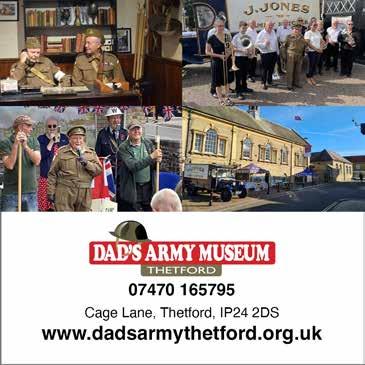

and groom’s families dispersed to their respective homes to continue celebrations with Ralph and Teresa commuting between the two through the February streets of Thetford, her still in her wedding dress and white satin shoes!
So already acclimatised to life in Thetford, what were Ralph’s views when in the 1960s, Redcastle Furze and Abbey Farm estates were built to accommodate more of his fellow Londoners? He says he thought it was too big, Teresa, agreeing, says the growth was overwhelming for a small town. In the meantime, Thetford has grown even bigger and although, maybe not the town it used to be, is still very much loved by the couple. Many readers will recognise Ralph and Teresa from their years working in the community, Ralph youngsters in the Thetford Community Projects Group, taking them on days out during school holidays and both of them with Lukemia Research as well as a ten-year stint with the “Dad’s Army” Museum.
Dennis and Mary Mead adapted to life in a small town well and lived out their lives here with Ralphs’s three brothers, Ray, Gary and Danny and two sisters, Kay and Julie all marrying and staying local, none of them being drawn back to life in the city - and would Ralph like to go back to London – absolutely not! After sixty-six years in the town, Teresa grants him the status of honorary Thetfordian! Fiftyseven years, two daughters, Shelley and Vikki, five grandchildren and four great grandchildren later, they are still very happily married, so in answer to my earlier question “how were the Londoners were received by the locals when they moved here?”, I quote an extract from a brief autobiography that Ralph gave me for background: “….yet, when I came to Thetford, people were wondering if the locals and the Londoners would get on well together. I would say we did, wouldn’t you?”



Written by Joanne Lock
Mick’s two heroes in life and the people who have inspired him the most are his mum and West Indies cricket legend Viv Richards.
Teaching and inspiring future generations runs in Mick’s blood. Mick’s mum led the way as the first black teacher in Thetford and was adored by the local community. She wrote a book about her life and experiences as a teacher entitled ‘Courage To Dream’ which was published in the same year as Barack Obama’s became President of USA.
Mick and his sister are now retired, but his nieces and eldest son Aaron followed in her footsteps and all became teachers.
Mick’s teaching career spanned 34 years at Thetford, Downham Market and London teaching a number of different subjects including PE, Design

Technology, Religious Education, philosophy and ethics to students aged 11-18.
For five years leading up to retirement Mick worked in Norfolk’s first integrated Alternative Provision, working with challenging students at Thetford Academy. These students had a number of conditions that resulted in socially and emotionally challenging behaviour including those who are neuro diverse. Many of these students faced permanent exclusion or had already been excluded and Mick provided support to help integrate these students back into mainstream education, a turnaround from exclusion to being productive members of the school and local community.
For Mick this was the most rewarding part of his teaching career, and he loves it when he bumps into former students and enjoys chatting with them.
Sat 13 & Sun 14 Dec 25 th th Friday 12 Dec 25 th
2pm 4pm 6pm 8pm 6pm 8pm
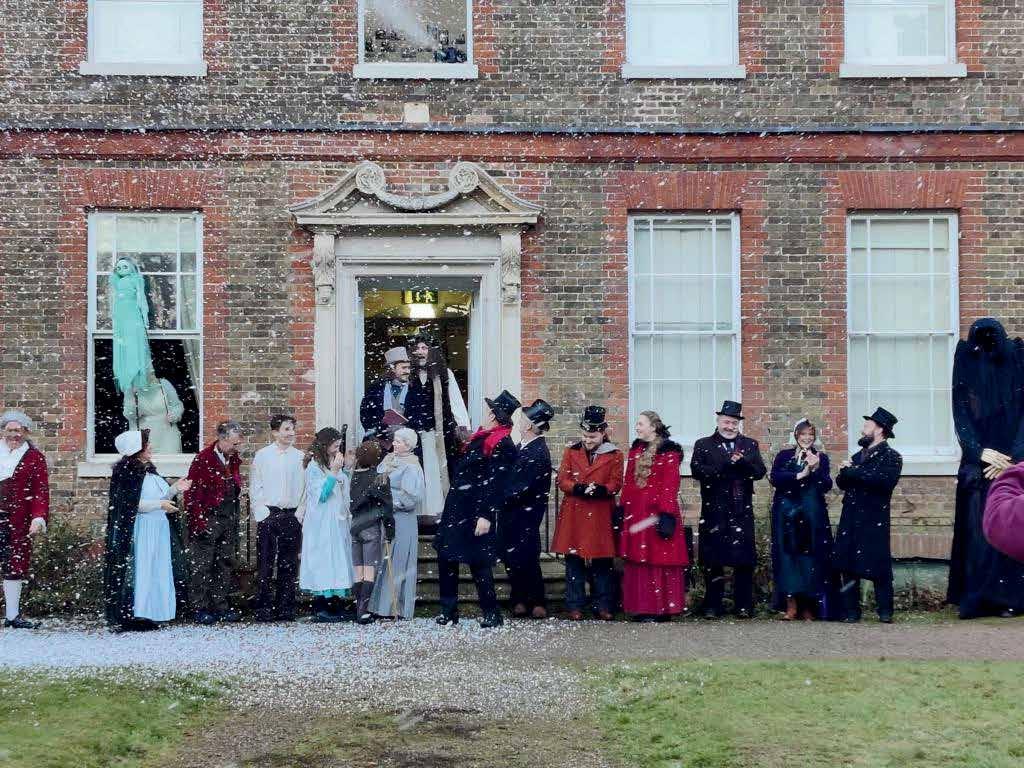
We are delighted to bring this timeless classic back to Thetford. Follow Scrooge and the ghosts as they show you what Christmas is really about. We will be performing a promenade play as we ‘take-over’ Riversdale for a magical Christmas show. Tickets limited to 20 people per show for an immersive experience.



Mick loves sports and always has from a young age. He played rugby at Thetford Rugby Club for twenty years and was both President and Chairman, but it was through his teacher Martin Eeles that Mick was introduced to the sport of cricket and joined Thetford Cricket Club age 13. Mick has served on the committee in a number of positions including Head Coach, Club and 1st Team Captain and is currently Chairman. Mick has mostly retired from playing now, but still plays for the second team.
Drawing Mick in for many reasons, he says cricket has everything in sport as there’s the tactical, mental, physical and emotional battle between batter and bowler. When batting you can shine as an individual as a destructive, big hitter of 4s and 6s, whilst still being part of a team.
Mick wanted to play sport because it sparks a desire in people to be the best version of themselves they can be, and along the way you meet wonderful role models of which there are many in Thetford.
When Mick first walked through the doors of Thetford cricket club as a young lad the pavilion was small, the ground was not well kept, there were very few juniors and only two teams, comprising 30 members.
Over the following years both Mick and Thetford Cricket Club developed and grew together and are very much part of each other.
The club has seen many changes and before becoming chairman, Mick has carried out a number of different roles in local cricket over the years and combined with his teaching career now has a wealth of experience under his belt to transfer into the club.
Mick was the head coach at Thetford for over 10 years and went on to be the head coach for Norfolk County Youth Cricket. He was also a player and coach at Old Buckingham and Diss where he was involved in developing the clubs and their squads and then went on to help set up junior teams for different clubs throughout Norfolk. Mick was previously both chairman and President of Thetford Rugby Club and was instrumental in raising £50,000 for the erection of floodlights, which are the envy of most clubs in Norfolk.
In 2018 the previous chair stood down and Mick (who had been a long-term committee member) was asked to take the reins.
The first challenge for Mick in his early days as chair was the pavilion rebuild project, but due to the impact of Covid, funding went down as the cost of building materials went up.
Luckily for Mick he’s not alone and has a supportive family, a fabulous wife Emma, a brilliant team behind him and many connections made with the local community and businesses that has enabled the club to begin their plans during those difficult times.
With help from our sponsors, Thetford Town Council, but particularly local company Team C and Shadwell Stud, who have always supported the community, the pavilion rebuild and new bar and kitchen was completed in late September.
The club has grown and gone from strength to strength and compared to the club Mick knew as a young man, today the club doesn’t just have a new pavilion it has fabulously kept grounds, which is official. A recent assessment by Norfolk Grounds Committee deemed it to be one of the best grounds
in Norfolk.
The club has grown in lots of ways. Finances are steady, the club is respected in the local community and wider area, it has built up a good standing in the county and has won a number of awards both county and national.
Mick is proud of the talented youth that are coming through in the sport, through the club’s development of young players and providing them with an environment and opportunity to play good cricket.
The number of teams has grown too and includes three men’s teams, ladies teams, three youth teams. Everyone is welcome to spend time and become part of the club, and it’s diverse, multi-cultural programmes with members from all backgrounds.
Mick and the team don’t just see the club as just being for cricketers, it’s for the community to enjoy by bringing the town’s community and the club together by holding an annual junior school festival which caters for over 400 young children over two days of fun cricket based activities.
The club also host an annual All Out Music Festival each September, which began 10 years ago in a small tent with a couple of bands and maybe 50 people in attendance.
Now the All-Out Music Festival has over 10 bands performing, has marquees and a fully operational stage setup on a trailer and an outstanding sound system to rival any music festival. With around 2000 people in attendance, it is a brilliant self-generated source of funds for the club.
In previous years, seeing a cricket field awash with people fully appreciating the bands, youngsters
having their faces painted and enjoying the fair rides and everyone relishing a variety of cuisines from the food trucks never fails to fill Mick with a sense of pride as he watches on.
So much has been achieved by Mick and his team and I was curious to find out about future plans and ambitions.
In the short term the club would like to further improve the training facilities and nets which would allow all teams to practice in an environment conducive to good cricket. It’s hoped that some sponsorship can be obtained from the ECB and governments £20 million ‘Plans For Neighbourhoods’ programme that Thetford is set to receive.
Next year Mick is hoping to support a youth and sport engagement committee, developing educational, careers and sports activities for young people in Thetford.
Supporting young people and sport has always been part of Mick’s life and combining the two helps to create and encourage a respect for self, the competition and the game.
Always to play hard but fair, be good sportspeople and be generous in both defeat and victory. A set of values that can be carried forward into all areas of life and ones that can encourage good citizenship and positive membership of society.
The club is always open and welcoming to new members - www.thetfordtown.play-cricket.com
Mick and Thetford are very much part of each other, there have been many changes and both the man and the town have grown together through all of them.



Told by Chelsea, words by Joanne Lock
When my dad was still around, my mum and dad had a difficult relationship. I was only little, there was lots of arguing and shouting, I was only little, I didn’t understand what was going on, it was scary, I was afraid and I felt unloved and uncared for.
My dad left us and I was left with anxiety, I would hide in my bedroom, isolating myself from others. This started when I was 13 and I would have one month hiding in my bedroom and sometimes a month where I felt able to try and get out and about.
There was nothing my mum could do to encourage me to leave my bedroom when I felt like this and when my friends rang me, I didn’t feel able to speak to them and hung up. This carried on until my early twenties.

School didn’t help my anxiety, I have learning difficulties, dyslexia, possibly I have autism and I am currently waiting for a diagnosis. I found speaking to people difficult so no one was able to get to know me to be able to understand me. I was different and there didn’t seem to be anyone else around who had special educational needs that I could relate to.
I was bullied and left school aged 16.
Catch-22 was a grade college for maths and English and where I spent the next four years to get my grades up and where I learnt work and life skills and cooking.
It took me a while to realise that the other students were like me and would understand instead of bullying. I was lonely and afraid to talk to others. I

would talk to myself instead.
One day some of the others saw me sitting alone and called me over and I was accepted in as a friend. I felt wanted and that I belonged there. I still keep in touch with my friends from Catch-22 on Snapchat.
When my time at Catch-22 was coming to an end, I was still lacking in confidence, I was anxious and I was scared about working in case I messed up and got fired.
The college suggested volunteering as a way to gain confidence in a working environment which would be both a safety net and stepping stone to entering paid work eventually.
Out of all the charity shops on the high street in Thetford, feeling nervous and fighting the overwhelming urge to go home and hide away in my bedroom, I walked through the door of the YMCA.
The first person I saw was Camille the manager who was warm, friendly and welcoming and I felt an instant connection.
When Chelsea first walked into the shop that day, she looked frightened. Chelsea kept her head down the whole time, struggled to make eye contact and wouldn’t speak.
It was some time before she would speak to the other volunteers or customers and Chelsea would always prefer doing the tasks that would allow her to stay in the back of the shop.
Gradually and the more time Chelsea spent at the shop watching the other volunteers being themselves, sometimes being a little bit silly and
having fun together and how the others would try and help her out, seeing herself in others she started to get more involved bit by bit and started doing some work on the shop floor.
Chelsea has come a long way since she started volunteering here, she is confident to join in with the other volunteers and to talk to people she doesn’t know. She takes the initiative to talk to customers and to show them something they might like in the shop and has also started to learn new skills like operating the till.
She has even got a little bit sassy, in a good way.
The other week Chelsea was helping me PAT test an exercise machine that had been donated and she convinced me to sit down on it and have a go. When I sat down Chelsea jokingly wacked the machine up to full pelt.
Thanks Camille and hi, it’s me Chelsea again.
At YMCA I feel safe and confident, my brother has seen the change in me and has also started volunteering here. I’m still struggling with my confidence and mental health and I am still afraid to look for paid work and I only work in the shop on days when Camille is in so I work five days a week.
Another important thing happened to me when I was working in the shop one day, I met my partner Terry.
Terry was just on his way through town after watching Top Gun Maverick when he saw something in the shop window, came in and started talking to Camille who he knows. Camille introduced Terry to me as we are both similar in age. I asked him for his number and we have been dating each other and together ever since. Terry still jokes about him being like Tom Cruise that day.


Now I’m with Terry, I’m going to places and doing things that even the thought of doing would make me want to hide away in my bedroom.
Terry is confident to share with people that he is autistic, living with ADHD and PTSD. Over the years Terry has worked out a number of coping strategies that we use as a couple which have helped me to feel safe and confident, which have made me feel able to push myself out of my comfort zone.
When I’m working Terry is around town to support me in any way I need. He drops by the shop and this helps me feel less anxious.
Once a week we sit down as a couple and plan and talk through everything that is going on in the following week and if we are going anywhere new we research where we are going and look at maps so I am already familiar with everything when I get there and stops me from feeling overwhelmed as I’ve got everything clear in my head.
Terry puts his tracker on when I am not with him and I find it reassuring to know where he is.
I used to love Lego as a child and since I’ve been with Terry, I love it again. We love to spend time together building Lego sets, it gets me out of my head, it’s a way to feel some structure and order and putting something together with the bricks kind of feels like I’m in a way putting myself together too. Terry feels the same when doing Lego which is why he got so into it.
Since working at the YMCA and meeting Terry, here are some of the things that I wouldn’t have even done or dreamt of doing four years ago. I can start conversations with people I’ve never met before.
Terry and I have days out to watch the banger racing, music festivals and we have been on holidays to Great Yarmouth.
Once with my work colleagues from YMCA we went to a Halloween party at someone’s house.
On my twentieth birthday I made a wish to one day live with someone and to have children. This is something that I didn’t dare to dream about because I was scared that it wouldn’t happen because of my mental health. Now I do, dare to dream.
Terry and I are talking about moving in with each other one day.
I would like to find paid work and if I could have my dream job it would be childcare.
Both of these thoughts, I never would have allowed myself.
I’ve come a long way, but I’m still concerned about my mental health and confidence and still scared about messing up if I get a paid job. I can’t get beyond that to give it a try. I have been trying to find some support for my mental health but everywhere I have turned no organisation has been able to provide any support.
Recently my dad got in touch asking if I wanted to hang out and I felt strong, powerful and confident enough to say no to him.
For anyone else out there who is struggling like I have, and still are, the advice that I would give to you and my younger self would be it’s hard, very hard but it really does help to make the effort to get yourself out and about and to talk to someone you don’t know. It just might surprise you.
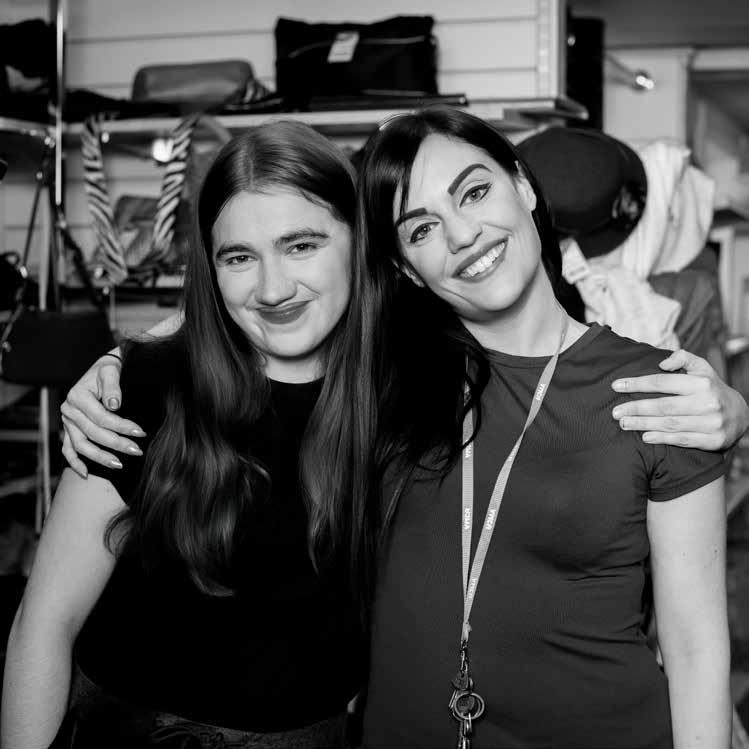


Written by Dave Griffiths
It’s eight o’clock on a dank, moisture laden, almost entirely silent October evening as I trudge down Old Croxton Rd, heading home after a late shift at the fuel depot. On this moonless night, the blackout renders almost complete darkness to the town, and I strain to make out my way ahead. I trip on a lifted paving stone, swearing as I bump into an unlit lamp post. I walk on muttering under my breath when the distant, faint but distinctive buzz of a doodlebug’s pulse-jet engine pierces the silence. I stop stock still and gaze into the distant piece of sky from where the noise comes, then look around to see if anyone else is doing the same. Of course not you idiot, it’s pitch black! I gaze back out again musing on how many other folks in Thetford are doing this very same thing at this very instant, from bathroom window or back garden. I get an anxious wave of nausea

in my stomach and a tightening in my chest, even though I know the chances of it hitting me are tiny. A million to one, 10 million to one; but facts are no comfort. The buzzing builds and, what’s, worse the point in the sky from which it comes doesn’t change. It’s heading right for me! The noise grows and grows until it sits directly above me. My breathing stops, waiting for the fuel to run out, the engine to cut and the heinous contraption to plummet straight down on me! It passes, the buzz subsiding; I’m safe. I turn and walk on relieved and even crack a faint smile at my irrational terror but just as quickly jerk back to the realisation that it’s now over the depot. I turn transfixed. And then the unthinkable. The engine cuts, the silence envelopes me whilst I wait for the impact. It comes, not with the explosion of fuel tanks or the collapsing of masonry, but the dull thud of bomb in sandy

Brecks soil. Tonight, we’re safe. Thetford breaths a sigh of relief and “keeps buggering on” as Winston would say.
On a recent sunny Saturday afternoon, I had the absolute pleasure of spending an hour with Thetford veterans Terry Banham and David Wright in Thetford’s Riversdale Centre. The experience was enhanced further as we were serenaded by the Brahms Sextet practicing in Riversdale for a later concert, a fabulous sound. I found out that Terry and David were born towards the start of the war (1938 and 1940 respectively) and so by its conclusion would have been 5/6 years old. I initially thought that their young war age would limit their memories of it and consequently the material I had to write about. But in fact, it was quite the opposite with their age giving a really different perspective. Spot memories, feelings, impressions, not facts and figures. Much more interesting.
As you may have read in David Williams fascinating article in issue 10, main drains didn’t come to Thetford until the 1950s so in the war most homes had no flushing toilets. Decades of under investment meant much of the housing was run down. A 30,000-acre swathe of farmland and villages had been cleared to form the Stanford Battle Area, 7 miles north of the town. Residents were forcibly moved and rehoused around the area, including in Thetford; forced to start over again. Add to the mix the shadow of war and its was not the rosiest of environments to grow up in. But I got no sense of disgruntlement from Terry and David at the hand they were dealt. Rather their stories were all about freedom, adventure, community, celebration. And in post war years, spreading their wings and partying!
In today’s world, the first 5 or 6 years of life are ones of time at home or adult supervised outings. I doubt many experiencing this would be able to recount many stories of adventure, discovery and derring do. However, it seems that back in the war years, pretty much as soon as you were able to walk, you were out with older brothers and sisters and friends experiencing the world. It would be unthinkable today, but the world was so different then. There were hardly any cars about, indeed David recounted that post war he could cycle out to Brandon and often not see a single one. But perhaps the biggest enabler was community and community care. Everyone knew everyone and by second nature would notice children in the street, notice if they seemed in any trouble, notice that they were further away from home than they should be. Assistance would be there if needed, the jungle drums would get messages to parents or family. Police were an integral part of this community with characters like the famous post war PC, Dinger Bell, seemingly appearing at incidents pretty much in real time! Today an adult approaching a youngster might be viewed with immediate suspicion; back then it was part of the blanket of community support.
That community structure stretched beyond the care of the young, however. In a place like Thetford, there would be no permanently staffed ambulance or fire service. If there was an incident, volunteers for both services would spring into action and come to the rescue. Terry talked of his time as a youngster post war volunteering as a St. Johns ambulance cadet. David’s father George was a mechanic at Lamberts and would be called out to car accidents to help cut people out of vehicles. Terry’s father was a carpenter and during the

Two American Boeing B-17 Flying Fortresses, the leading heavy bomber of the Eighth Air Force, take to the skies.
Source: Public Domain.
war years would be called out to help repair bomb damage. Average wages at the time were about £5 a week, folks couldn’t afford to pay trades people to do these repairs or attend breakdowns. Life ran on cooperation and community, a far cry from today where such spirit only appears in pockets of the community. In such an environment, through the war and early post war years, Terry and David talked a lot about being out and about playing and having adventures. A lot of their stories and memories centred around the river, playing on it and around it. They would fish and swim, but both had vivid memories of what they termed Bully Tanks (the Norfolk version of Belly Tanks). Planes returning from bombing raids that had sustained significant damage, to make landing as safe as possible, would jettison anything they could over open ground. Spent fuel tanks, Belly Tanks, were one of the favoured items being heavy and detachable. You can almost picture the scene of a group of youngsters, playing in woods and fields, coming across a tank for the first time. An investigation, a scratching of heads, a bright idea and a leader emerges. Next thing you know they are dragging the tank to the river where a couple of intrepid folks climb on and get launched, cheered on from the bank. Then the realisation they had no way to move or steer the tank so the eldest on shore had to jump in and swim to the rescue. For the next voyage they had an oar, and then they find a second tank and strap it to the first with planks. Then someone’s father cuts a hole in the tanks, and you can sit in your ship. You get into trouble and normally find a way out of it, occasionally you might need rescuing. Perhaps a day grounded then back to the river the next day! I get the sense that’s the way life as a youngster went, roaming free, finding something
new, having fun, getting into scrapes, getting in trouble then out again for more.
I got a sense from our conversations that at their young age, whilst aware of war and danger, the guys weren’t as encumbered by anxiety at what they saw around them as adults; it was all they’d ever known. They talked of the doodle bugs but more in the sense of excitement to rush out and see them and the suspense of when the engine would cut rather than worry that it might hit them. David explained that after the war there was a bombing range out at Euston where the RAF would practice their precision bombing. He recounted lying on a haystack at night listening for the distant thunderous rumble of a Lancaster bomber on approach for its bombing run. It would pass overhead and, as it entered the range, send out an avalanche of photo flash flares to light the target area before dropping ordinance. The impact of the bombs was something of an anticlimax, with more of a pop rather than a ground shuddering explosion from the small charge bombs used. The planes would then wheel away back to base. For a youngster, son of a mechanic who loved all things motors, it was a huge thrill.
Coming into the meeting I had lazily assumed Thetford, as a relatively small, rural town would have had quite a quiet war. How wrong I was. Terry and David reeled off over a dozen military bases around the region. The fuel depot for many of those bases was located on the Old Croxton Road as well as a CSD (Command Supply Depot). It was therefore a target for bombing, making Thetford a town constantly on standby. These establishments also had a major impact on the operation of the town. Generally, road traffic during the war was very
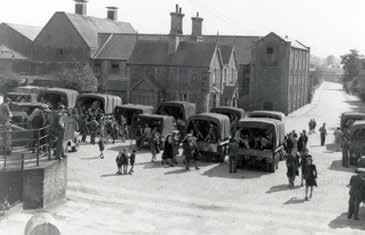
USAAF servicemen and local women, Thetford, Norfolk, getting together for a Saturday night dance. Around 70,000 young British women became ‘GI brides’, crossing the Atlantic to start new lives with their American GI husbands at the end of the war. © IWM. FRE 13701.
light but war brought a constant stream of fuel tankers (pipelines to some bases came post war), trucks, tanks etc. into the town. At the time the main A11 came into town from the Norwich direction and ran down White Hart Street, Bridge Street, rejoining the route of the current London Road. Old Croxton Road heads north from the White Hart Street junction and, given the narrowness of the streets involved, you can imagine how congested roads would be with lorries, tankers and military equipment. The guys taught me something completely new about the non-military road traffic in the war time era. Apparently, there were steam vehicles quite commonly seen on the road! Stanley Steam cars and Foden 2 Stroke Steam Lorries. They must have been hard work to use, lighting the fire early in the morning and having coal in the cab to feed along the way. Not a huge surprise that they died out rapidly with the spread of the petrol and diesel engines post war!
Through the war, military personnel were a common sight in Thetford, British and Irish in the early years with increasing numbers of Americans in later years. I was interested in what Terry and David’s impressions of the Americans were as youngsters in contrast to some of the tensions you hear about amongst the adults. Their immediate response was unsurprisingly sweets! Sweets were so rare that kids used to chew on lotus beans (animal feed today) and liquorice roots to get their sugar fix. A supply of sweets was like gold dust and immediately endeared the Americans to the young. They recalled that the Americans would put on a children’s party at East Wretham Airbase, laying on transport to get them there and back, happy days and lasting memories. I asked about whether they were aware of any tension
or trouble between the Americans and British military. Both Terry and David didn’t recall that there was a lot. They recalled more tensions between parts of the British forces, especially when the Black Watch and the Enniskillen Fusiliers were both in town; things at times got a little heated!
I was interested in how the atmosphere around the town changed at the end of the war from a youngsters perspective. They talked of the VE parties but particularly remembered a children’s street party held at the end of St Nicholas Street, near the entrance of Abbey Farm. Terry’s memories of the change in atmosphere at the end of the war was one of relief but also tinged with enduring sadness. Bad news of some of those lost in the conflict was received during the war, but many were missing in action with little or no information. You could only wait and hope. The end of the war brought the bitter/sweet discovery both of loved ones lost and happy reunions with those who made it through. So, the euphoria of a conflict over was tempered somewhat by sadness and loss and the realisation of more hardship to endure in the post war years.
So, my time with Terry and David was up and after photos with Martin, I thanked them and bid them goodbye. I was left with the lasting impression that what the war years lacked in material standard of living it made up for in community and a determination to just get on with things. As we see instances when communities across Britain turn on each other in hard times, I can’t help but think we could learn a lot from the society of the 1940s and 50s. A strong community is so powerful especially in challenging times.




Written, Maps and Photography by Stephanie Downes
When I first moved to Thetford and began walking my previous dog along the river close to Nun’s Bridges I would pass a couple of concrete structures, each with a metal pin on top. I used to wonder what they were used for and after a little bit of searching I was able to find out that they were Spigot Mortar bases.
Spigot Mortars are WW2 anti-invasion defences that were strategically placed near junctions or railways for example and the gun was mounted on the steel pin (Spigot). I soon discovered that Thetford still has quite a few Spigot Mortars dotted throughout the town as well as a few Pillboxes.
This walk starts at Nun’s Bridges car park and will take you past some of these WW2 relics. From the car park cross the green footbridge to
the opposite side of the river, turn left and begin walking towards Nun’s Bridges Road. Along this path is the first Spigot Mortar, tucked under a Weeping Willow tree on the edge of the river.
Continue along the path and when you reach the road, carefully walk across the middle bridge in the direction of Ford Street, immediately after the bridge turn right into a track alongside the River Thet. A short distance along this track is the second Spigot Mortar.
Head back towards Nun’s Bridges Road and cross straight over and down a track in front of you, the track leads to some gates/private property, just before you reach the gates is the hardest to find Spigot Mortar on this walk, it’s hidden under lots of undergrowth next to the remains of a small flint wall with only the steel pin on top visible.


Return back down the track and then turn right before crossing both bridges, turn into Mill Lane and walk along the grass verge. When you approach the right hand bend in the road you will see some housing in front of you, just in front of the white house in the first Pillbox that you will see on this walk. Continue the walk along Mill Lane and when you reach the Thetford Ex Service Club turn right into Bridges walk. From Bridges Walk you will need to turn left onto Butten Island, walk through Butten Island passing by the statue of Maharajah Duleep Singh and onto the three way bridge, take the left hand exit off the bridge and walk along the riverside towards The Light cinema. Cross straight over Bridge street and continue onto Haling Path. Haling path starts at the grade II listed Town Bridge which dates from 1829. A small distance along Haling Path is the second Pillbox of the walk, this Pillbox, placed to defend the Town Bridge is built into the wall of the Grammar school and covered with flint, out of view behind the wall there is another Spigot Mortar next to the Pillbox in the grounds of the school.
It’s now time to head back to Nun’s Bridges car park, walk across the Town Bridge and then head right along Riverside Walk, follow the river up to the old mill and then turn right onto Bridges Walk, just after the footbridge turn left onto Spring Walk. This is a very picturesque area of the town, passing the back of St Audrey’s Mill and Spring house with a handy information board all about this area and definitely worth a read. Continue along Spring Walk, past Lady Gentle Meadow and finally back to the car park.
This walk will show you just a few of Thetford’s remaining WWII relics, there are plenty more to find and the walk can easily be extended to take in others such as the Spigot Mortars on
Abbey Meadows, Glebe Close, White Hart Street and Brickfields Way behind Mundford Industrial Estate. There is also a Pillbox in the Mundford Road allotments which can be seen by a track next to the railway line at the top of Old Croxton Road.
A few more Pillboxes are scattered around the outskirts of the town and there is one on private land just off Norwich Road as well as a Spigot Mortar on private land in Redgate.
Over the years Pillboxes, Spigot Mortars and Air Raid Shelters have been removed/demolished from around Thetford, if you ever walk across Melford Common towards Park view you can spot the remains of the concrete base of a previous Pillbox in the grass.



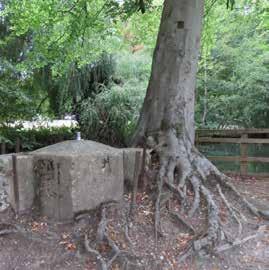



Written and Photographs by Andy Greenhouse
The tale of the Thetford Tunnels is going to be a long time in the telling.
The stories that have been passed down over the years, urban myths, vague rumours, second-hand witness reports, and not to mention pure speculation, have all combined in the melting pot of local intrigue to produce what is truly a confuddling conundrum! And sadly, we shall likely never find the answer… My search for that answer started a few months ago, with the mission to investigate the existence of a tunnel that was purported to have existed at some point, joining The Bell Hotel to Kings House. This was the first instance of inconclusiveness that I would encounter for, although it was almost certain that there had been a tunnel of sorts, what remained was a bricked-up wall where the tunnel should have gone forward, with no record of what lay behind it.
Not to be deterred, I continued my investigations, reaching out to the people of Thetford for

their stories and memories. Before long, as the response started to trickle in, I started discovering a whole subterranean world hidden away beneath our feet.
Soon, I was delving into many of these underworld chambers in the hope of finding a connection and eventually I gained access to the holy grail of Thetford’s forgotten history, the cellars under King’s House.
With the original King’s House having been built in the 17th Century, the background is incredible. Different owners, including King James I, have added or removed various features over the years, but the defining point, for the purpose of this story at least, has been the extensive cellars under the floorboards.
In the last issue of this magazine, I showed the layout of the cellars that I’d mapped. I also included the narration of when I was accompanied by John Julian, a renowned local medium, who picked up on many spiritual energies that were

emanating from various locations in the cellars. At one point John said he could sense people ‘hiding’ for protection, and of others in uniforms and ‘tin hats’ that were helping them, and the idea that the cellars were used as a shelter against airraids during the war was investigated. The closest I could get to confirming this was when after having asked for memories and information, I was directed to the Extended Defence of Britain Database which is an interactive map of the UK that can show the location of a whole range of different defensive structures that existed at one time or still do in some cases. In this case, I was obviously looking for Air Raid shelters, and lo and behold, there was one at No. 1 Whitehart Street. The map states that it was removed. However, the map had it located more in Bridge Street than Whitehart Street, at the premises on the corner (marked by an inverted horseshoe shape), which is currently used by ‘Instinctively Mystical’ (see map page 112). When I visited the shop to enquire about it, I was told there was no cellar and another dead-end was recorded. It wasn’t until Martin picked up on a lead that I realised the map was slightly out for it would seem that Hudson Estate Agents, the opposite side of the Minstergate to the Mystical shop, and actually at No. 1 Whitehart Street, apparently had an impressive cellar!
I went there as soon as I could. I spoke with the very helpful Steve and explained my mission and before long he had prised up the hatch in front of the photocopier to reveal what lay beneath!
Hudson’s Estate
Access was literally a hole in the floor through which I had to clamber onto a step ladder to reach ground level. Steve jokingly asked if I had my wellies so you can imagine what I was expecting
but once I was down the floor was solid, though there were signs of water presence.
The room was quite large, probably a good 20-25 feet square, with a sense of damp and mustiness in the air. At the bottom of the ladder, I stood and faced what would be the front. It consisted of a brick wall in the centre of which there appeared to be a section that had been done separately. Was this a bricked-up doorway to a passage or tunnel? If it was, and it went in a straight line, it would have gone up King Street alongside St. Peters graveyard. It becomes another unanswered question. (see pics 1-3, 10 and 11)
To my right was the wall that would be alongside Minstergate. There was much in the way of paperwork and files stacked up against it so it was difficult to ascertain what exactly was there, but there was a section that again seemed to be a bricked-up doorway that would have led to who knows where! (pic 5)
Also along this wall was a familiar looking alcove. These recesses in the wall, with a curved top have appeared regularly in the various cellars I’ve visited, and I can only surmise their purpose to be for lighting, for somewhere to place candles etc. (pic 4)
To my left was an entrance to a passage that curved away toward the front as well. What I found interesting here was the curvature of the walls. Where one might expect to find rightangles in constructing basic walls and rooms, someone had gone to the trouble and effort of creating curves where right-angles would have more than sufficed.
Also of great interest was that this passage was very short but going by the direction of the curve at the far end, and the position of the different brickwork I feel fairly certain the passage would have continued, heading up Whitehart Street. (see pics 6–9)


Could this have been an air raid shelter? Possibly, but given the absence of a solid ceiling (it was just the office wooden floor), it’s doubtful, unless the bricked-up walls led further and deeper underground or to more solid, safer rooms. Could this have been even older, and part of a more extensive network of subterranean tunnels and passages connecting various locations of ancient Thetford? Oh I do like to think so!
* * * *
Part Two of this series left off in issue 10 with a hint of something exciting to be found at the Black Horse pub across the other side of town, located at the junction of Magdalen Street and Melford Bridge Road.
An old friend, Terry Gillman, is the landlord there and I had originally contacted him with a view to talking about the tale of the donkey that had fallen into a disused well in the back garden, only to discover the existence of an old flint mine. But just prior to my visit, I realised this story had already been covered! I went along anyway as Terry had told me he’d also got some interesting tales to tell.
The Black Horse Pub
(See pics 12-21)
Terry started by showing me some photos of the donkey incident and we had a quick chat about that subject, though I explained that I didn’t need to pursue it further as it had already been written about in a previous issue.
I asked him what other stories he could tell me, as per his comments in our messages.
His astonishing reply was that there were tunnels, or at least the remains of them, out the back and would I like to have a look! I didn’t even finish my drink, and out the back we went.

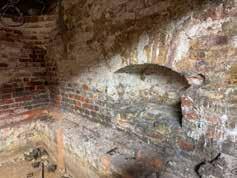
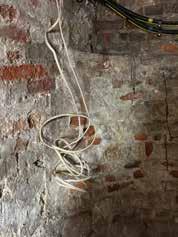
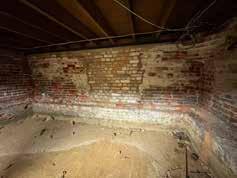
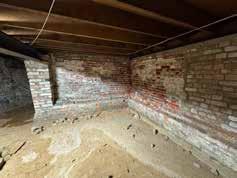



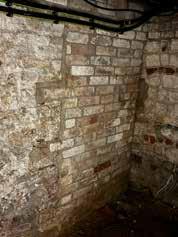
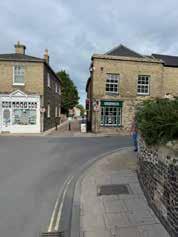
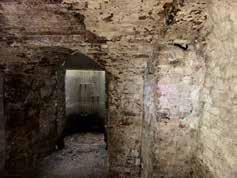




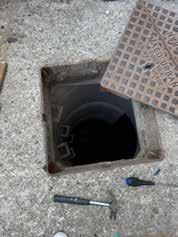




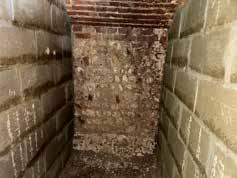
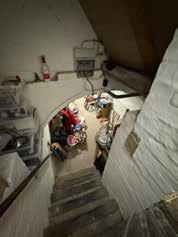
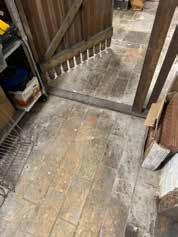
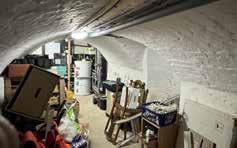
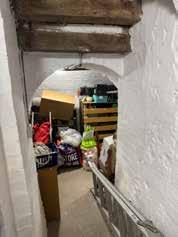







Once he’d found some tools to act as the makeshift ‘manhole key’ he was soon fiddling around with the cover. It looked just like any drain cover, metal and heavy, but it was soon dragged out of the way to reveal, the ubiquitous, hole in the ground!
No rickety step ladders, or slippery narrow stairs to negotiate this time though… this doorway to the deep had been reinforced with concrete half-pipes with 5 metal rungs to climb down on, which I did, very gingerly, until reaching the floor about 10 feet down.
Going forward a few steps brought us into a ‘room’ that had brick walls all around, and also a solid curved ceiling of more brickwork. Everywhere was the familiar cloying odour of damp soil and brick, and the sense of age and hidden history. And the mystery of the yet more unanswered questions. Who dug all this out.. when…why? Where did the tunnels go to or come from?
To the left was an arched doorway which would lead through into the actual pub cellar had it not been bricked up, but immediately to the right and behind me, and off to the right at 90 degrees to the other, were the beginnings of two tunnels, leading off in different directions, but unfortunately these had been filled in and bricked up! There was an abundance of fresh-looking bricks, breeze blocks and concrete, suggesting this had been done fairly recently, rather than a long time ago.
The one that would have led off in a southerly direction seemed smaller and showed signs of having had a major fill-in before having been bricked up, whereas the one that would have gone off towards the east was the larger and had extensive brick and breeze block work to block it off.
Where both of these used to lead to, or where they
came from we will sadly probably never know for sure, but from what Terry told me, of the stories that some of the ‘old boys’ that used to frequent the pub have passed on, there used to be a tunnel network linking many of the old Thetford pubs, of which there were many back in the day, with the Bidwell brewery in Old Market Street that was used to deliver barrels of beer.
The idea sounds incredible in principle and perhaps something like this did exist, possibly utilising the myriad of flint mines and lime pits that supposedly criss-crossed beneath Thetford, but in reality would something like that have really been worth the effort to create, just to replace the need for a few dray horses and wagons? And there did use to be a lot of pubs in Thetford. But given that a line from the Black Horse to the Brewery would cut across Castle Street and just about circumnavigate Castle Hill and the amount of pubs that used to be in just that area alone, it does give credence to the many stories concerning tunnels, voids, pits and sinkholes that have been documented in the area.
The timeline works well with the story for both the Black Horse and Bidwells.
The Black Horse dates from the mid-18th Century, and beer was actually brewed on the premises until the 1860s, at which time the pub was sold to Bidwell and Company.
Bidwell & Co was founded around 1710 and was centred around the impressive brewery building in Old Market Street. I am told there are large cellars underneath with evidence of tunnels but the building is now empty with the last occupants having vacated a couple of years ago.
In much the same way as Kings House was important, I feel the gaining access to the Bidwell cellars to be my next mission. My attempts to contact the previous occupants, Lovewell Blakes, to see if they could help proved fruitless so I’m


open to suggestions on how to get down there! Likewise, if anybody has any snippets or titbits of information that might be able to add anything to this story, I would love to hear from you!
Please contact me at: andy.greenhouse@sky.com
* * * *
STOP PRESS!
A latecomer to the story to add yet more to the fabulous tapestry of Thetford’s history, The Paddock in Ford Street.
After speaking again with Chris Goddard (The Portrait Lady, issue 10 of the Reflections magazine) she put me in touch with the lovely people, Steve and Philippa, at The Paddock. Chris has been following the Tunnels story with great interest, and she had been chatting with Steve about the subject, and it came to light that their house is steeped in local history, connected to Bidwell’s and possessed a large cellar with the remains of a tunnel! She put me in touch with Steve, and I promptly planned with him to go and visit! Both the visit and this addition to the article were done on the very last day before the deadline for publication!
They kindly let me take a few photos which are included here (see pics 22-27)
(Any information I have about the house, apart from being related to me by Philippa and Steve, has been gleaned from a copyrighted information booklet, ‘THE PADDOCK - HISTORY OF A HOUSE’, written by David Woods, a previous owner of the house.)
The Paddock
When it was first constructed, or for whom, is not known for sure, but its first appearance was on the
Town Enclosure Map of 1806, so it’s likely to have been just prior to this.
The first written reference came in 1850 when one ‘Thomas Bidwell Esq’ was recorded by Slaters Norfolk Directory as living there. By the mid 1880’s the house had been extended as shown on the 1882 Ordnance Survey map.
Soon after this, residence passed to Robert Burrell, son of Charles, but by 1888 The Paddock was occupied by Charles Henry Reynolds, who lived there for over twenty years according to Kelly’s Directory. He was Bidwell’s Brewery Manager.
So, the connection to the Brewery was well and truly set.
Fast forward a hundred years or so and there I am, standing in the cellar of a house that’s steeped in local history.
The latest occupants, Steve and Phillipa, have only been there around three years but have already stamped their mark on it. Steve showed me around the ground floor which has many of the original features, and then, obviously, into the cellar, which was reached by a steep stone staircase of about 12 steps.
It was the epitome of what I’d come to expect every good cellar should look like, from the lowslung curved ceilings and wonderfully whitewashed walls to the well-worn brickwork walkways, curious recesses, abruptly ending alcoves and dourlooking drain holes.
The doors themselves were of solid, ancient wood, with magnificent hinges and latches that bore the mark of workmanship rarely seen today and still worked perfectly despite the rust of years of use. As you come to the bottom of the steps, one of the first things you see is a fabulous array of pipework... a spectacular display of plumbing expertise connecting boilers and tanks and all manner of dials and switches, and all mounted on
a large black backboard. Steve explained that this was all in place when they bought the house. It was situated here as there had been no other viable positioning for the pipework.
Behind all of this was, apparently, yet another rumour of a tunnel that will stay forever unseen. The remains of the tunnel, if it had existed in the first place, had been filled in and the bricked up, and the board fixed in place. In its time of existence, the tunnel led toward the old Jail house, which is directly opposite, over the road. It also led toward the Brewery.
Its purpose and destination, and indeed proof of its actual existence remain, like much of my previous investigations, unknown. Apparently, other buildings, further down the street, were also part of the Bidwell property empire, one of them reportedly having been used as a storage or warehouse. Perhaps they too were part of the tunnel network to ease access. Another avenue of investigation awaits me in this never-ending conundrum.
* * * *
What has become perfectly clear though, from all the dead-ends and blocked-up passageways of my ongoing research, is that while it is understandable that modern society needs to fill in these underground voids in order to support their buildings and foundations, in the same respect it is frustrating that much of our heritage and history is being buried for ever and the generations that might have given the answers are also gone, and all that’s left are the whispers from the past.
To be continued….
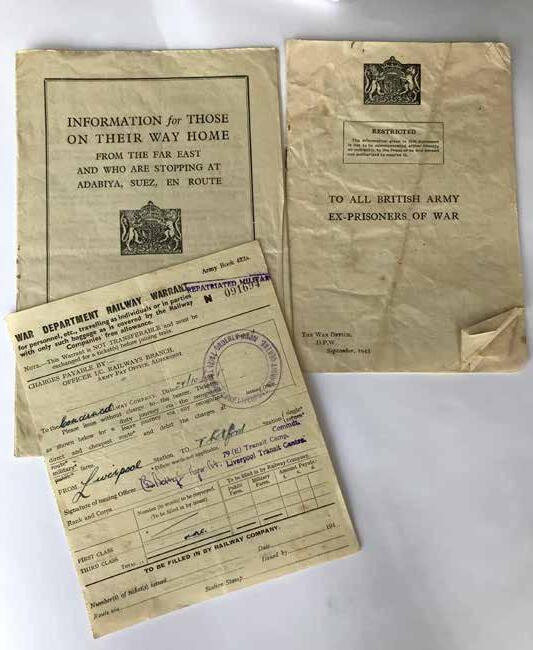
‘A sample of the booklets providing instructions and advice to ex POW’s and the rail warrant issued for the final leg of the journey home, issued to Peter Starling.’
Further stories of those who served in the forgotten army.
Written by Sandra Starling
by Sandra Starling
Whilst Thetford celebrated Victory in Japan Day, (VJ Day), on 15th August 1945, with bonfires and a candlelit procession, many of the Far East Prisoners of War (FEPOW’s) were not officially told that the war was over.
My father, Peter Starling, was in a camp hospital in Changi Prison in Singapore. Early in the morning of the 12th August, there was a buzz of anticipation on the ward. The prisoners were excited, rumours had begun to circulate that the war was coming to an end. A new type of bomb had been dropped on Hiroshima and Nagasaki in Japan, however, it was not until the 20th August that an official announcement was broadcast across Singapore.
Over in Japan, pow, George Angus, was in a camp in Omine, a mountainous area, where he was made to work in a coal mine. He was officially told the

war was over on the 22nd August.
It seems that only a few from Thetford, including Bill Massingham, who was in a camp just outside the port city of Nagasaki, where the second atomic bomb was dropped on the 9th August, knew officially on the 15th August that the war was over and that after three and a half long years, they would at last be going home.
It would take several weeks before repatriation troops arrived at the prison camps. For those in camps near to Nagasaki, the port had to be cleared of debris as a result of the atom bomb being dropped before troops could land on the island. For others, including George Angus , it took repatriation troops a while to find camps hidden in mountainous terrain. Finally, Australian troops arrived and George and his fellow prisoners were taken to the port at Nagasaki, arriving by train on


the 22nd September. It was a sobering journey, they were some of the few westerners who saw for themselves the devastation wrought by the dropping of the atomic bomb. George and fellow Ex-FEPOWS were placed on an aircraft carrier and taken to Okinawa. Along the way the medical teams warned them against overindulging but it was a difficult ask after almost four years of only having small quantities of boiled rice to eat. It was also the first time in years that they slept in a lice-free billet. In Okinawa they were transferred onto a troop ship and taken to the west coast of America. En route, they docked in the Philippines and on the 1st October George was able to send a telegram to his wife and family - “I am safe in Australian hands. Hope to be home soon”. However, George and his fellow travellers were to find themselves on the most extraordinary journey home. The troop ship docked at San Francisco where they then travelled by rail to Vancouver in Canada then back to the USA and to New York. Everywhere they went, they were warmly welcomed and fed on a diet of hamburgers, doughnuts and coke-a-cola. After a few nights stay they boarded HMS Queen Mary for the journey to England. They docked at Southampton in November 1945. Whilst no explanation for this seemingly strange route home was given, it is likely that the purpose was to fatten up the emaciated bodies of these now Ex- FEPOWS as a result of three and a half years of malnutrition, disease and brutal treatment.
Meanwhile in Singapore, my father was released from hospital and was back living in a tent with five others in the exercise yard of Changi Gaol. Then, in the first week of September 1945 the Royal Navy sailed into the ports of Singapore. The repatriation troops were shocked at finding fellow servicemen now skin and bone, suffering from various diseases
they had never heard of including beri-beri and dengue fever, as well as malaria and dysentery and all living in squalor. It made many of them wonder how man could treat fellow human beings so cruelly.
The wait to go home continued. It was tortuous but was eased for Peter by being given the job of driving members of RAPWI (Returned Allied Prisoners of War and Internees) around the City of Singapore. On one such occasion, he was tasked with driving staff members to the Scotswood Hotel. There he ate a slice of bread and butter for the first time in three and a half years.
Whilst in Singapore, Admiral Lord Mountbatten, Supreme Allied Commander, South-East Asia, made a speech stating that the Imperial Japanese Army had issued an order that all POW’s were to be annihilated by any means available. He added that the Allied invasion of Malaya and Singapore was scheduled for the 10th September and no consideration could be shown for the POW’s.
Finally, on the 27th September 1945 those from the 18th Division that were in Singapore embarked on the troop ship Marshall Sobieski. Back in November 1941 it was the smallest in the convoy of eight ships that took the 18th East Anglian Division across the North Atlantic. Now she was large enough to bring home all members of the 18th Division that was left in Singapore.
The journey home for my father and his close friend Reg Mercer was more straightforward. There were stops along the way including the port of Adabiya in Egypt, for the issue of winter clothing and uniforms. In a booklet issued to those on board the Marshall Sobieski entitled ‘Information for those on their way home from the Far East and




who are stopping at Adabiya, Suez, en route’ there was a small paragraph on the second page of the fifteen page document headed ‘Interrogation Forms’. They were advised that they would be given an ‘interrogation form to complete’ and they were to ‘hand the completed form to the interrogation officer who will be present’. M.I.9 (Military Intelligence, Branch 9, responsible for intelligence tasked with assisting evaders and escapers) were keen to know if any of them had tried or succeeded in escaping. The form, also known as the ‘Liberation Questionnaire’, required the servicemen to first list all camps that they had been in and include the officer in charge of the camp(s) listed and then detail any attempts at escape. These documents are now kept at the National Records Office. One particular soldier from Brandon, was clearly not in the mood for listing the camps he had been in and simply wrote across that section of the form in large capital letters ‘MUNEROUS’ !
Further paperwork included the booklet ‘To all British Army Ex-Prisoners of War’. This twelve page instruction/advice booklet, issued by the War Office, started with the headings Status, Rank, Service and Security. Another heading ‘Arrival in England’ covered disembarkation: the opportunity to send a telegram to their family confirming they were now on British soil, the issue of ration cards, advice on pay and accounts as well as leave: they were given forty two days repatriation leave.
The paragraph covering security and the additional document handed to the servicemen originally entitled ‘Guard Your Tongue’ was controversial: the document was watered down and later editions had the title ‘Warning’. Regardless of the edition, the instruction for them all was ‘not to grant interviews to the press,

‘FEPOW
A.G.M. Friday 16th October 1953. Green Dragon’ is inscribed on the back of the photo.
Seated left to right. No 1 Reg Mercer. Far Right Peter Starling
Standing left to right. No 3 Bill Massingham, No 6 Syd Aylott, No 7 George Mower.
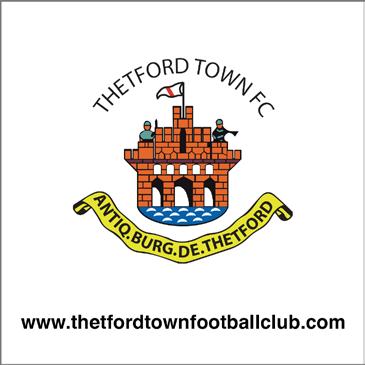

newsreel or broadcasting representatives, unless permission is given’. The original additional document went further telling the reader not to talk freely about the deaths of fellow servicemen. There was an understandable concern by the authorities regarding the feelings of those who had lost loved ones and friends at the hands of the Imperial Japanese Army. However, it was the authoritarian tone that the ex-fepows disliked: after a long period of incarceration and harsh treatment, the last thing they needed, was to be treated to more of the same.
The Marshall Sobieski arrived at Liverpool docks 3 p.m. on Tuesday 24th October. As they walked down the gangplank, my father thought it strange that it was covered in tarpaulin. It was as if the authorities did not want civilians to see the emaciated bodies of servicemen arriving home. Another memory he had of arriving at Liverpool, was seeing an advertisement for Jeyes cleaning fluid. After three and a half years of living in utter squalor, he found it an irony to see such an advert.
There was an overnight stay at a military camp close to Liverpool. The damp cold weather was taking some adjusting to and most of the servicemen slept in their uniforms. Next morning, they were issued with travel warrants and my father, Peter, made his way home on the train travelling via Peterborough. It was the first time he had been on a train since working on the Thai-Burma railway (later known as the Death Railway). Memories of being herded into a cattle truck with thirty five others, living in cramped conditions, oven-hot during the day, freezing cold at night, with few stops for toilet breaks, food (a handful of boiled rice) and water, could not have been far from his mind. Excitement at being only hours away from home must have been tinged
with anxiousness. How would one explain the skinny body, the scars and the strange illnesses that were there for all to see? There was also the sadness and guilt of leaving behind the friends and comrades who had died. Approximately half of the men from Thetford who had been part of the 18th Division had died either through fighting to defend Singapore, suffering from malnutrition and disease or through allied bombings of ships that carried FEPOWS who were being transported from Singapore to Japan.
The train arrived at Thetford Station at 6pm, 25th October 1945, one week short of four years since he had left Liverpool Docks with some of the 18th Division for ‘destination unknown’. He was met by Mr. Barns, his manager from the Ibex tea and coffee mill in Watermill Lane, Thetford, who had thoughtfully brought his car to take Peter back home to King Street. Peter wrote in his notes that he was glad of the lift home as his kit bags were heavy. Also there to greet him was his sister Marie and her new husband Eddie. An early lesson in how life had carried on whilst he was a prisoner of war.
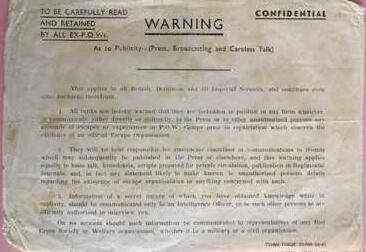
‘Peter Starling’s copy of the ‘Confidential Warning’.
George Angus also travelled home on the train and arrived at the railway station late one November night 1945. His daughter Doris was eight at the time and clearly remembers being taken with her younger brother George to meet him. Doris instantly recognised her father and after lots of hugs and kisses they made their way home: a new temporary home the council had found them as a result of a collapsed ceiling in their cottage in Castle Street. There was much excitement in the Angus household, Dad had come home with presents and lots of American chocolate.
During the forty two days leave, the Ex-POWS


received further paperwork regarding medical examinations and pay and, although stood down from active service, they had to keep their uniforms ‘just in case’. Because Peter was ill with malaria, he had his leave extended and returned to work at the coffee mill on the 14th February 1946. His illness saw him and some of his fellow Thetford FEPOWS spending periods of time in the military hospital at Ely, well into the 1950’s. Others, who had run their own business prior to the war, found themselves too ill to continue and would work for local companies between bouts of ill health. Poor health affected George Angus as well and impacted on his love of playing football for Thetford. His bones had become brittle and the breakage of bones resulted in him taking up the role of coach.
The physical impact was evident to their families and friends but the psychological scars the exFEPOWS presented were perplexing - what were they supposed to do? There was nothing in the booklets issued to guide people about such trauma. The now familiar phrase Post Traumatic Stress Disorder - PTSD - was coined after the Vietnam War. As an example, Peter would sometimes disappear. On one occasion, his mother found him hiding under the dining room table. Some could never attend the annual Remembrance Day Service, the memories being too much to bear. Regardless of the ‘Confidential Warning’ to be careful of what they spoke about in case they upset the families of those who did not return, most could not talk about their experience anyway. Thus the close ties that were formed by FEPOWS would last throughout their lives, they understood each other in a way others would never be able to.
Alongside the physical and mental trauma, was
the coming to terms with a community that was exhausted after years of war. Everybody wanted to forget the war and move on. The country was changing rapidly, Churchill was no longer Prime Minister, a new Labour Government had come to power in the July of that year. They felt forgotten and began setting up their own associations, some of which merged and became the Far East Prisoner of War Association. FEPOWS from Thetford and Brandon set up a local branch of the Association and, with subscriptions, supported widows and families of those who did not return home. It also gave them a much needed space to talk, if they were able to, about their experiences, and the issues of adjusting to civilian life that lasted for some, for the rest of their lives.
Having formed a local branch of the Far East Prisoner Of War Association, they had a formal part to play on Remembrance Sunday, the laying of a FEPOW wreath at the War Memorial in the Market Place. They would also mark VJ Day in much the same way and in addition would place a small article in the Thetford & Watton Times reminding local people of the sacrifice their comrades and fellow Thetfordian’s from the 18th Division had made.
As Remembrance Sunday draws near we should all take a moment to pause and remember the sacrifice they all had made in making our lives safe.
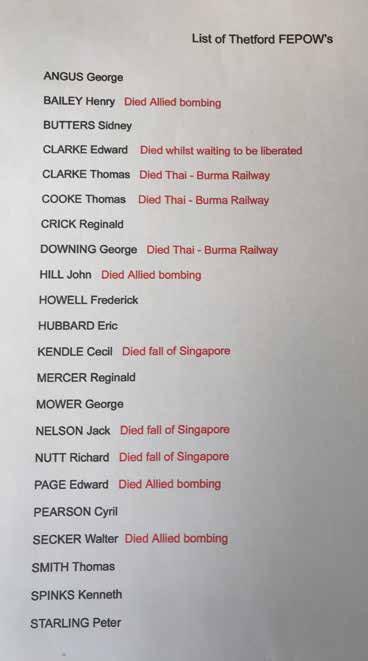
‘The list of of Thetford FEPOW’s that were part of the 18th Division. It lists the names of those whose postal address was Thetford.’

Transcribed from hand written text by the magazine team

An anonymous donor gave *Reflections of Thetford* an old leather suitcase, originally found at Thetford Railway Station around 1920. After being passed down and long forgotten in an attic, the case was rediscovered, containing three finely bound notebooks marked with the initials “M.R.J.”. Inside were handwritten notes—at first appearing observational but later revealed as mysterious tales set in and around Thetford. Though the author remains unknown, the stories reference local landmarks. Due to the fragility of the pages, the magazine has carefully scanned and transcribed them, and now presents the second of these books to its readers.


6 Bridge Street, Thetford IP24 3AA 07969 585183 www.moomoospiercing.com

Drama-centred social group meeting weekly in Thetford for play readings, workshops, script writing and rehearsals.
We are keen to hear from amateur actors, (men & women), for a challenging British First World War drama; ideally aged 1835 for this exciting project, but all ages 18+ welcome as we have many other productions planned. Acting skills useful, enthusiasm essential! Email: encoretcthetford@outlook.com


It was in the autumn of 1887 that I found myself in the Norfolk town of Thetford, a place which, though not without its bustle, still retains an air of the ancient about it. My visit was prompted partly by antiquarian curiosity, for Thetford is rich in relics of the past—ruined priory walls, a mound of uncertain origin, and, most pertinent to my studies, certain ecclesiastical manuscripts preserved in the keeping of the Corporation.
I had secured lodgings in a respectable inn near Castle Street, a thoroughfare that winds down from the great mound itself towards the more populous part of the town. The street, though narrow, is of some antiquity, and the houses—chiefly of brick, with curious irregularities in their façades—testify to generations of alteration and repair. It was here, amid the sounds of carts upon cobble and the evening calls of tradesmen, that my first inkling of something amiss reached me.
The landlord, a hearty fellow by the name of Brooker, was quick to offer conversation. “Castle Street, sir,” he told me, “has seen more than its share of odd business. You being a scholar, I daresay you’d be interested to know that tunnels run beneath half the houses here—old passages, they say, leading to the Priory and sometimes further. Smugglers used them, so my father swore. And before that—well, who’s to say?”
I expressed polite interest. Secret tunnels are common enough in the traditions of any old town. Yet I marked the way he glanced toward the darker end of the street, where the lamps seemed always dimmer, as if reluctant to shed light.
My true business took me to the Guildhall, where, by favour of the Town Clerk, I was permitted to examine a sheaf of papers recently unearthed during some
renovations. Among bills, indentures, and accounts of rents, there was one manuscript that drew my particular notice: a thin book bound in limp vellum, written in a crabbed seventeenth-century hand. Its title, or rather the note on its first page, read:
“Concerning ye Gentleman Cloaked, seen in ye Streets about the Castle, whose feete are not as other men’s.”
This strange heading caused my pulse to quicken. The text that followed was a confused mixture of testimony, half in Latin, half in vernacular English, describing appearances of a tall figure, cloaked and hooded, who was said to be glimpsed after dusk in Castle Street. Several witnesses declared that though his step was muffled by his garment, the prints left behind on damp earth were not those of boots but rather split, as of a goat or some cloven creature.
The manuscript spoke also of “subterranean wayes, made long since by ye Monkes,” and of how the cloaked figure was “oft seene to issue from and return into” such concealed passages. One unlucky man, a mason, claimed to have followed the figure and found a door in the cellar wall of a house in Castle Street, “wherin he vanished suddenlie, and I heard a clattering as of iron hooves on stone.”
The document ended abruptly with a prayer for deliverance.
Such tales, though clearly folkloric, are precisely the kind of colour which illuminates local history. I determined to take a copy of the manuscript and make further enquiries among townsfolk.
Castle Street by Candlelight
That evening, returning to my lodgings, I took the liberty of walking Castle Street from end to end. The air was keen, and a mist gathered low against the ground. At


the far end, where the street narrows, I noticed a house boarded up, its windows shuttered and roof in some disrepair. The sight reminded me of the mason’s testimony.
Pausing there, I confess I felt a curious unease. The lamps seemed few, and the shadows long. I thought I heard a slow scraping sound, as of something dragging along stone just beyond the range of my vision. Yet when I turned, the street lay empty, save for a stray dog nosing at refuse.
I returned hastily to the inn, somewhat ashamed of my nerves.
Later, as I prepared for sleep, I heard Brooker belowstairs cautioning another lodger not to be abroad too late. His voice carried through the thin timbers:
“Best keep clear of the Castle Street end after dark. Folks say he still walks.”
The next day, while examining charters in the quiet hall of the Corporation’s library, I became aware of a presence beside me. A tall gentleman had entered noiselessly. He was clad in a long dark cloak, the hood of which cast his face entirely in shadow. Thinking him some fellow researcher, I made to offer greeting, but before I could frame the words, he passed the desk and was gone.
The odd thing was this: I had heard no footstep upon the boards, though they creak readily beneath the lightest tread. When I hurried to the doorway, the corridor was empty.
I mentioned the matter to the clerk in charge, who looked puzzled. “No gentleman has been here this hour,” he said. “You were alone.”
On the third evening of my stay, a circumstance arose which set the seal upon my disquiet. Brooker, in his cups, related how the cellars of the inn were connected with certain old passages. “Blocked up now,” he said, “but when I was a boy, we dared one another to creep in. My brother swore he saw a cloak trailing round a bend, though none walked before him.”
At once my curiosity was inflamed, and I persuaded Brooker to show me the cellar. By lantern-light we descended stone steps slimed with damp. At the far end of the vault, beneath a row of barrels, the wall showed signs of rough patching. “There,” he said, tapping the brickwork. “That’s where it went.”
As he spoke, a cold draught stirred, though no gap was visible. The lantern guttered. And—I declare it solemnly— we both heard the sound of a heavy step upon stone, followed by another, nearer, and then a faint metallic ring, as of hoof striking flag.
Brooker crossed himself and hustled me back up the stairs.
My sleep that night was broken. A little before one, I awoke to the unmistakable sensation of cold air moving about the room, though the shutters were closed. There followed a sound: fabric dragging across boards.
With trembling hand, I lit my candle. At the far side of the chamber, half in shadow, stood the cloaked gentleman. His face was still hidden, but the outline of his figure was tall and narrow. The cloak hung low, yet beneath its hem I glimpsed—unmistakably—feet that were not human. They were cloven, dark, and seemed to smoulder faintly, as if each step bore an ember.



www.ticketsource.co.uk/magicfloor-productions www.ticketsource.co.uk/magicfloor-productions

I could not cry out. My limbs were leaden. He moved toward the door without turning his hooded head. The latch lifted though no hand touched it, and he passed soundlessly into the corridor.
Released from my paralysis, I seized the candle and followed. Down the stair, across the hall, and out into Castle Street he went, always a few paces before me. No other soul was abroad. The lamps flickered as he passed. He turned toward the shuttered house at the end of the street and, reaching its door, melted into it without opening.
I stood shivering in the mist until dawn tinged the sky.
The Clergyman’s Tale
The next day, resolved to seek explanation, I called upon the Vicar of Thetford, a kindly man named Rev. Alington. When I spoke of what I had seen, he regarded me with grave eyes.
“Sir,” he said, “you are not the first. In my cure I have heard many such accounts. The figure has been known here for centuries. Some say he was once a monk of the Priory, who delved too deeply into forbidden studies. Others that he was a stranger, a sorcerer of the Continent, who made compact with unholy powers. His cloven feet betray his allegiance. The tunnels were his ways of travel. And as for that boarded house—it stands upon the site where once a chamber of the Priory lay. I counsel you, do not pursue the matter further.”
The Final Descent
But curiosity proved stronger than caution. That evening I returned alone to Castle Street, lantern in hand, and forced entry into the shuttered house. Dust lay thick, and the air was rank with mould. At the rear I found a stair descending.
The passage below was narrow, cut in stone, and sloped into darkness. My lantern shook as I advanced. Presently I reached an arched door half fallen away, and beyond it a chamber of considerable size. The walls were lined with niches, as if for the dead, and in the centre lay a slab of stone, altar-like.
There, upon the slab, rested the cloak. Black, moth-eaten, yet somehow full, as though a body occupied it.
I dared approach. The lantern-light fell upon the floor before the slab, and there I saw the prints: fresh, in dust undisturbed for ages, sharp clefts as of hooves.
The cloak stirred. A hooded head rose. Though no face showed, I felt the weight of eyes upon me. The lantern went out.
What followed I cannot wholly recount. There was a rushing of wind, a sound of clattering hooves upon stone all about me, a choking stench of sulphur. I fled in blind panic through black corridors, stumbling, tearing my hands upon unseen walls, until at last I found myself in the open air, lying upon the mound near the Castle.
I quitted Thetford the next day, my research unfinished. To this hour I cannot endure the sound of hoof upon stone without trembling. The manuscript I had copied I destroyed, fearing that to preserve it might be to invite further visitation.
Of the boarded house in Castle Street, I am told it has since been pulled down. But the townsfolk say that on misty nights a tall cloaked figure may still be glimpsed at the corner where it stood, and if one listens closely, the faint ring of iron-shod hooves may be heard retreating into the depths below.

Back by popular demand, we are publishing a a few of the letters and correspondence we have received from some of our avid local readers.
To the Editor,
Whoever the gentleman is who lectures the 3:15 bus queue about the superiority of custard creams over bourbons, please carry on. I haven’t caught that bus in weeks, but I still come to listen. It makes waiting for public transport feel like a university seminar — albeit one with more shopping trolleys.
— Enlightened by Biscuits, P. Clarke, Brandon
To the Editor,
An Update. The gentleman at the bus stop has moved beyond biscuits and now delivers lectures on whether seagulls are actually just pigeons with ambition. I missed my bus because I didn’t want to leave midargument. Can the Gazette print a timetable of his appearances?
— Enlightened Commuter, P. Clarke, Brandon
Dear Editor,
I stopped at the town noticeboard yesterday to find three adverts for yoga classes, a plea for a missing cat, and a handwritten note that simply read: “Beware the badger.” No contact details, no explanation, just those three words in bold. I now live in constant suspense. Which badger? Where? And why exactly should I beware? I considered ringing the council, but
didn’t want to sound foolish. So I’ve taken to carrying a torch and a packet of digestives wherever I go. If I should encounter this mysterious beast, I hope biscuits will prove a satisfactory peace offering.
— Yours cautiously, Sean H, Thetford
To the Editor,
I know some complain about the accordion player by the market cross, but where else can you hear ABBA followed immediately by “Greensleeves”? It’s musical time travel, and it only costs whatever coins you have left after the jam stall. Thetford would be duller without him.
— Happily Tuned, L. Rowe, Croxton
To the Editor,
I was inspired to write after reading the letter of comment in the last edition, regarding the geese by the river.
The ducks in Castle Park now outnumber the tourists. Yesterday I saw one leading a guided tour and quacking at the Norman ruins. The visitors applauded. If the town isn’t careful, the ducks will have their own tourist board, complete with glossy brochures.
— Alarmed but Impressed, R. Taylor, Thetford
Dear Editor,
At Saturday’s market, I confidently asked the fishmonger for “two nice fillets of cod.” He looked at me pityingly, shook his head, and handed me a plant pot. Turns out I’d wandered onto the gardening stall. I didn’t want to lose face, so I paid up and went home with what I can only describe as the finest marigold I’ve ever fried in batter. My wife claims I’ve finally gone vegetarian by accident. If any readers know a good recipe for tulips in breadcrumbs, please let me know.
— With best wishes, P. Tanner, Methwold
Dear Editor,
I wish to bring to your attention the matter of the hedgehog currently residing in my front garden. At first, I was delighted. A hedgehog, I thought, how charming, how rustic, how very “Visit Norfolk.” But three nights running it has rearranged my solar lights into what can only be described as a runway. Last night they spelled out the word “GO.” I am concerned this hedgehog is attempting to attract aircraft. Or possibly UFOs. Either way, I have notified the RAF, and also my cousin Derek who once saw something unusual near Lakenheath. He said it might have been a bin bag, but you can’t be too careful. If the creature succeeds in summoning extraterrestrials, I ask that the council provide adequate parking for their craft. We already struggle on market days, and I don’t want to see a flying saucer taking up the last space outside Greggs. — Yours in vigilance, R. Jones, Thetford
Dear Editor, Few people realise the River Thet was once considered so important that Julius Caesar nearly
invaded Norfolk just to paddle in it. This is documented in my neighbour’s scrapbook, which also contains her winning recipe for treacle tart. - Mavis, living next door to Fred
Dear Editor,
I have invented a device to solve the pothole crisis. It is, in essence, a bicycle with springs attached to the wheels, so one can bounce merrily over any crater in the road.
On my test run, I achieved a personal best of three and a half feet of air over the pothole on Mundford Road. Unfortunately, the landing was less graceful and I found myself in a neighbour’s wheelie bin. Still, this proves the concept works. I will continue developing “The Bouncercycle” once my elbows have stopped vibrating.
— Yours innovatively, M. Burrish, Thetford
Dear Editor,
Many people walk past the public toilets near the market without realising they stand upon ground of immense historical significance. Excavations (conducted by myself with a garden fork, before I was asked to leave) revealed what may well be a Saxon crisp packet.
Some scoff at my discoveries, but I remind you that historians once doubted the Vikings ever came to Thetford. Yet I have it on good authority (my neighbour’s cousin Colin) that a Viking once tried to trade a helmet for three turnips and a jar of pickled onions.
It is high time we install a plaque. I am willing to design it myself — in biro, if the council’s budget won’t stretch to stone.
— Respectfully, Hayley S, Thetford







